Aidan: A lot of things can happen in a decade, though two of those things appear not to be flying cars and self-tying shoes. Ten years is a long time and a lot of anime has been made. Just going by an average of 30 shows a season, in ten years that would mean 1200 anime series made. 360,000 minutes of entertainment, though don’t check my math on that. To consider the amount of work that has gone into the creation of so many shows is truly mind boggling and is worth my utmost respect. So late as we are to the party, we decided to make a list of the top fifty shows of the decade. Take note that this list was the product of all writers voting, so any complaints about what should be here or why something isn’t higher on the list can be reserved for the democratic process. This is mainly just a list for fun and maybe a resource for anyone to take a peek at a show or movie they might have missed. So to cap off this decade of shounen brawls, otherworldly reincarnation, animated waifus and all of the emotions, let us reel off some of our personal favorites. And may there be many decades of anime to come to show the world just what animation is capable of.
#50: Girls’ Last Tour
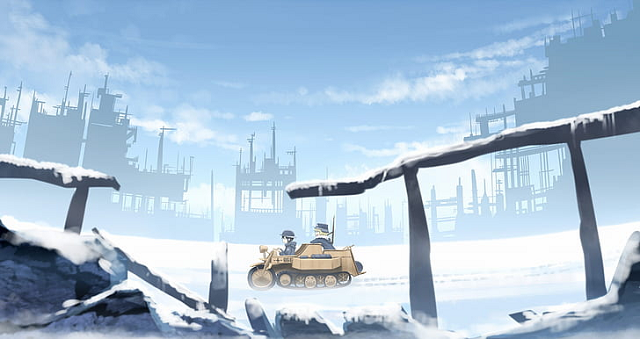
Aidan: When it’s all over, when the last day falls and our history ends with a bang or a whimper, it’s a wonder who will wander our monoliths of civilisation after we are dead and gone. Girls’ Last Tour’s setting is an easy way to get cold hard depression, with it being about two girls wandering through the world after everything is over, the very world alien and devoid of any meaning to both them and us. However, in a twist, the story – while not shying away from the bleakness of the situation – instead focuses on them finding small rays of happiness in the last days of earth. Naturally if everything is already over, then why bother getting sad over it? So for a show set after the unspecified apocalypse, it’s surprisingly upbeat, making for a relaxing watch. It makes you think that if these girls can cheerfully sing, “It’s hopeless!” in the worst situation, whatever has you down is small stuff in comparison.
Mario: Girls’ Last Tour falls within my favorite new trend that emerged in the anime medium over the last decade: dark moe anime. Set in a post-apocalyptic world where the human race is almost extinct, our two girls wander around the world in their Kettenkrad looking for food and shelter. If it sounds a bit bleak and minimalist, rest assured that Girls’ Last Tour is at its heart a slice-of-life show about those girls having a relaxing time in that world. The show could be entertaining and soothing enough with just those factors, but it has more tricks up its sleeves. More often than not, Girls’ Last Tour ponders some basic philosophical questions about our own existence, our purpose in life and even what life is itself. Moreover, the anime adaptation enhances this show further with consistent audio-visual production and great attention to detail. Depressing and comforting at the same time, Girls’ Last Tour is a rare show that produces unique charms and distinctive tones, while always keeping its feet firmly on the ground.
#49: Fune wo Amu
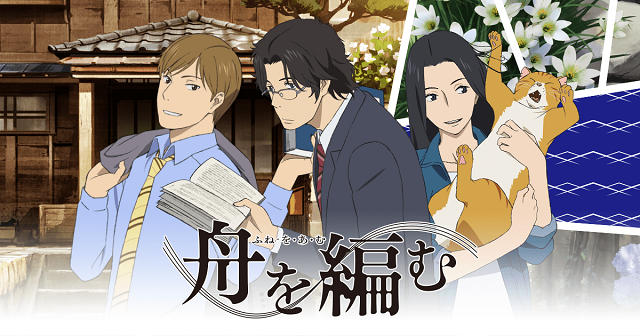
Lenlo: Fune wo Amu is a series that, to my knowledge, has passed under many people’s radars. No one really talks about it, it never comes up in anime conversations, it just sort of… exists. And yet it exists as one of my favorite character dramas of the decade, only losing out to truly seminal works of fiction higher on this list. It should come as no surprise then, when I tell you it was written by Shion Miura, who also wrote Run With the Wind – another fantastic character drama that sadly missed its place on this list only barely. The way Miura crafts characters across all of her works is like few others to me. Each one feels like a fully realized human being, set in a tangible, well-crafted world. Meanwhile her narratives are never grand, nor far-reaching, instead telling small stories, of little consequence to the world at large. They’re filled to the brim with meaningful interactions, dialogue and themes, though never too much to weigh the viewer/reader down, or make the works feel too dense. I could go on for paragraphs about Miura’s work, so instead I will leave you with this: Watch them. Watch them all.
Wooper: How do you make an anime about dictionary compilation interesting? Fune wo Amu attacked this daunting task with a three step plan. First, emphasize realistic character animation. If your show is set largely in offices and meeting rooms, your characters’ successes and failures need to be evident in their facial features and body language. Second, use a dual-protagonist structure. As a linguistic savant, Majime couldn’t have carried the show alone – the emergence of reluctant everyman Nishioka as one of the dictionary’s biggest champions was a stroke of genius. Third, find the perfect metaphor to connect your show’s obscure subject to the lives of everyone in your audience. I won’t spoil the choice that Fune wo Amu made on this front, but I’m convinced that it couldn’t have done better. At just 11 episodes, it’s one of the decade’s best compact dramas.
#48: Kaguya-sama: Love is War
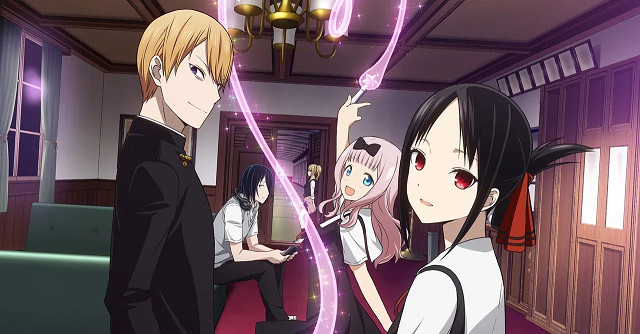
Amun: It’s a rare day when all the authors of Star Crossed agree on something, but Kaguya-sama was unanimously chosen as an outstanding comedy. And for good reason – solid characters, clever skits, and a memorable dance turned another student council anime into something special. Pitting the two types of Japanese elites against each other – bootstrapped but brilliant vs millenia old perfect pedigree – would normally devolve into tired retrodding of stereotypes. Kaguya and Miyuki, despite their abilities, are still very much high school teenagers – and their overpowered approach makes them all the more endearing. Many high school anime come and go, but Kaguya-sama is a comedy worth remembering.
Wooper: Kaguya-sama succeeds as a comedy due to its exaggerated characters, sharp editing, and urgent bouts of romantic one-upmanship. All of its creative elements work together to prove the show’s comedy bona fides, from patterned backgrounds to stellar voice acting to clever use of tropes. But the thing that gives it top 50 status, at least in my mind, is the natural shift into dramatic territory near the end of its first season. “I Can’t Hear the Fireworks,” the show’s two-part finale, dug deep into Kaguya’s isolation and sorrow – far deeper than I expected as a non-manga reader. The moment when she reunites with her friends and realizes the depth of her affection for Shirogane is among the most heart-stopping in recent romcom history. Kaguya-sama skillfully walks the line between sweetness and silliness, delivering an entertaining package that stands tall within each of its many genres.
#47: Konosuba
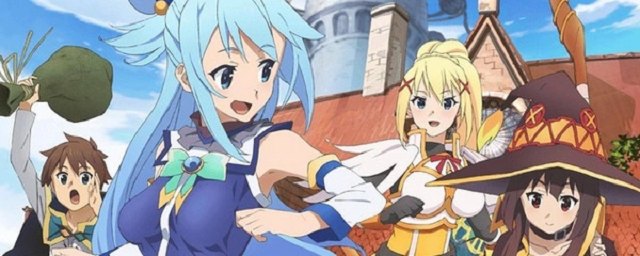
Helghast: Animated by Studio Deen, a studio that had no right to have two smash hits in a single season, Konosuba is an isekai about nothing and that in itself is its greatest strength and weakness. Being a parody of the isekai genre, it takes the seriousness out of the equation and injects its version of humor that allows for the four core members of the party to go on their goofy adventures and wreak havoc wherever they go. The three main females are all waifu material in their own demented way, whether it’s the most useless goddess ever of Aqua, the masochistic tank of Darkness or the fan-favorite of Megumin whose sole utility is casting the single biggest explosion possible. Kazuma himself is one of the biggest trolls in anime and is far more relatable than your stock goody-two-shoes male protagonist. On the other hand, the story never seems to progress much when it comes to the overall world that our misfits find themselves in, but then again, that’s not the point.
Aidan: Anime comedy has always been something which never really grabbed me. I generally found it too reliant on “Shout till it’s funny” humor and “Let’s make an entire series with only one joke,” but Konosuba was the one exception where the comedy just works. The jokes aren’t disconnected from the story, but instead feed into it, with even previous one-off jokes spawning entire episodes dedicated to the consequences and hilarious incidents afterwards. The Konosuba cast bounce off each other like old friends stuck together, whether they like it or not, and whatever the situation you know funny times will be had. The characters aren’t there for the comedy, the comedy is there for the characters. Even Studio Deen’s rather low quality animation gives the show a degree of charm. I personally hope to see many more adventures from these four delightful idiots.
#46: Silver Spoon
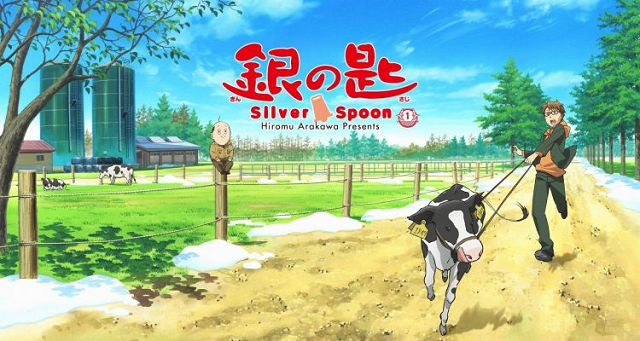
Armitage: No one eats meat in my family. Well, no one but me. But I have always felt very guilty for not being able to resist that juicy steak and those mouth-watering pork-chops. Growing up, I was told by my mom (in a futile attempt to convert me) that it’s such a cruel thing to take an animal’s life just to make a meal out of them. Surely, the people who do this as a profession must be heartless. And then, back in 2013, I watched Silver Spoon. A story about Hachiken, a city boy, sheltered from the harsh country life, who decides to enroll in an agricultural school. With that, Hachiken gets a fresh start, and encounters people who influence who he is as a person and introduce him to a way of living which might have always been foreign to him. And along with everyday lessons about milking cows, rearing horses and caring for cute piggies, Hachiken learns about something far more valuable – empathy. That’s what Silver Spoon teaches us above everything else: How to care. And because of it, I am now able to have my beef bowl and know the real reason why it tastes so good.
Amun: Some call it “Farm Simulator”. Some call it “City Boy gets learned”. I call it brilliance. Silver Spoon shows a side of Japan often not explored in anime – the countryside. Since the vast majority of the genre is set in either Tokyo or a variant thereof, both the protagonist and viewer get thrown into a world we haven’t seen much of before. Furthermore, the Tokyo arrogance getting taught a lesson by the “rural bumpkins” really warms my heart. But SIlver Spoon is more than that – it’s about finding an alternative to the salaryman lifestyle. And it does it with charm and endearing characters so we all remember that there’s more to life than the next deadline, and the world (and anime) isn’t as homogenous as we often believe. Silver Spoon will warm your heart and every bit deserves its place on this list for its unique take on growing up in modern society.
#45: Tsuki ga Kirei
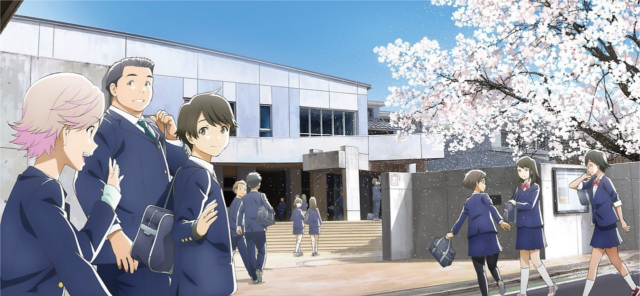
Wooper: Tsuki ga Kirei is quiet, understated, and if you’re on the same wavelength as its characters, shockingly powerful. What makes it special is its sense of authenticity; both romantic leads are anxious and self-conscious, and they struggle not only to be open with each other, but also to excel in their other responsibilities. Akane runs track, while Kotaro is a traditional dancer and aspiring novelist, and these parts of their lives bleed into their relationship in convincing ways, giving the show a lived-in sensation. Though the show’s visual presentation is spotty, the story had me captivated from as early as the second episode. I’m no industry expert, but if I had to guess, I’d say there won’t be another young romance anime on this level for a long time.
Mario: Tsuki ga Kirei is breathtakingly intimate in low-key narrative scope. The story that it tells – detailing the first love relationship of our young Kotarou and Akane – is decidedly simple and mundane, but honest enough that it feels more like a love story taken from your best friends’ lives. It has that “sincere” quality, something that the anime medium often fails to achieve with “moe” and other exaggerated character types cranked up to eleven. Tsuki ga Kirei has a great flair of visual storytelling, using a show-don’t-tell approach that often focuses on small moments and little gestures, rather than big emotional melodramatic payoffs. The characters are the most natural group of kids that feel exactly their age: naive, inexperienced and pure. This show ends up at the top of its genre as I consider it the most effective romance anime out there.
#44: Little Witch Academia (OVA)
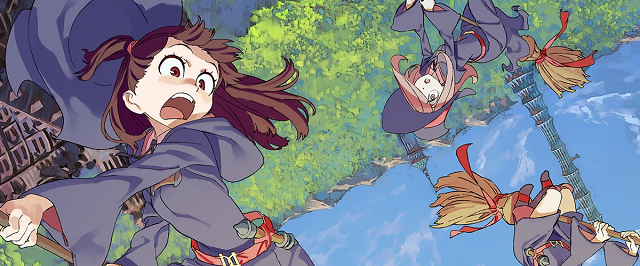
Aidan: It’s a little disheartening that two OVAs could contain so much greatness that the TV series sorely lacked, but here we are. Once upon a time I used to watch Saturday morning cartoons and they held a magic that really is missing today. The plots may not have been the best, nor the animation all that great, but they were undeniably a gateway that lead to anime. Now anime is great, you get the medium of animation exploring themes one could only dream of with cartoons. But sometimes there is a small nostalgic desire to return to a simplistic time where animation could just be magical. Little Witch Academia is the pure crystallization of that feeling and in these two episodes you have so much joy and fun packed in that it’s hard not to smile as antics ensue onscreen. The plot isn’t original nor do the characters stand out, but you would have a hard time finding something else that can take this premise and just execute it effortlessly. So if you ever feel like embracing that inner child for an hour and a half then grab a blanket and stick this on your TV.
Lenlo: There were a lot of things I expected to find in anime, but Disney wasn’t one of them. A bit silly of me really, the West takes inspiration from anime all the time. So why should it be so odd to find them taking inspiration from the West? Because the best way for me to describe Little Witch Academia is if Disney made Harry Potter, but an anime. And while the 25 episode series has issues, the original OVA from 2013 is everything I love about the series condensed into 26 minutes. It’s beautiful, fun and full of energy, with passion bleeding out of every pore. Makes sense, considering it was originally created as part of Japan’s 2012 “Young Animator Training Project” – effectively a bundle of money given to studios to let young new animators make anime at no risk of financial loss. And based on what it spawned, and how successful the series was in general? I’d say it was a good investment. Well done Japan.
#43: In This Corner of the World
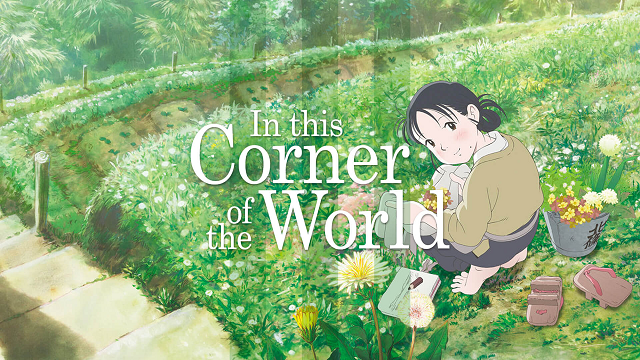
Mario: Coming to Corner, I originally expected another war treatment in the vein of Grave of the Fireflies or Barefoot Gen – a full-blown loss-of-innocence drama about the horrific consequences of the war for normal citizens. I was taken by surprise by how Corner instead focuses on the ordinary life of Suzu, on her little moments of living her life, the life that she has no control over. The whole film is painted in a way that makes it feel like a memory, a look back at the harsh period of Japan with a tender perspective, an outlook that is both bitter and sweet. In Corner, there’s no big emotional outburst on display, there’s no angsty statement to be found at the horrible injustice of war. Quiet, subtle, humane, true to life, and strangely humorous and warm, Corner is a perfect example of a work that can shake off all the flashiness to seek for something real, substantial and simple. The result, of course, is far from merely “simple” and “ordinary”, but powerful in every aspect.
Wooper: In This Corner of the World is a war film, but its star is not a soldier. She is a daughter, a dreamer, a wife, an artist, a victim, and ultimately a survivor. We meet her as a girl, witness her evolution into a woman, and watch as she grapples with poverty, injury, and death. The film is not a bleak one, however, which is the secret to its success. Suzu spends more time standing in ration lines than she does crouching in bomb shelters. Her attempts to stay in the good graces of her in-laws occupy a great deal of the film, and their conversations reveal vibrant personalities underneath the hardships of civilian life during World War II. When tragedy strikes, Suzu’s resolve to stay with her new family falters, but their mutual love proves stronger than any military force could ever be. Rather than concern itself with depictions of human cruelty, In This Corner says something vital about the human spirit, making it one of the best animated war films to emerge from Japan in many years.
#42: Tsuritama
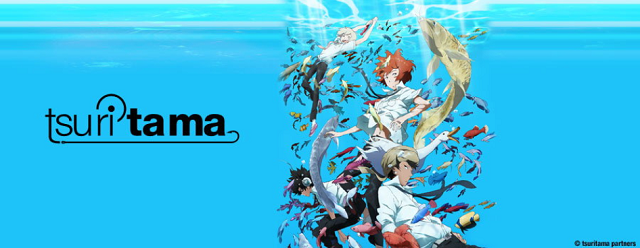
Wooper: Tsuritama is a story about both the difficulty and the value of connecting with others. Despite their individual hardships, the cast slowly bonds over fishing, a hobby that prepares them to save the world from a deep sea creature with dangerous mind-control powers. Admittedly, Tsuritama doesn’t totally stick the landing where its larger mythology is concerned. Its smaller, more personal dramas and their touching resolutions are the real draw, particularly Haru’s decision to ally himself with Earth at great personal cost. The series also boasts a stirring color palette and a soundtrack that keeps the business of saving the planet light and fun. Whether they’re braving stormy seas or just learning to sink a lure in a bucket, hanging out with Tsuritama’s cast is a rewarding experience for anyone willing to try something off the beaten path.
Mario: Tsuritama is one rare show where you can see the director’s unique vision and love bleed through every part of it. Tsuritama has this vibrant color palette, a bright art style and a sense of humor communicated through visuals that makes it stand out from the rest. The whole premise is pretty weird, too, being about fishing, and the way the show puts these four boys with totally different personalities together sparks some strange but refreshing chemistry. Amidst its eccentric styles and characters, Tsuritama is a heart-warming tale about friendship that allows them to overcome their own flaws to work together and literally save the world. Tsuritama is brimming with such originality and passion that it’s a shame that it gets overlooked by the anime community.
#41: Vinland Saga
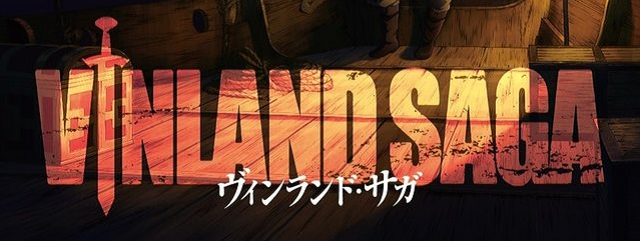
Lenlo: What is there to say about Vinland Saga that I didn’t say in my review? It’s a stellar period drama from Makoto Yukimura, who also wrote Planetes. The man has a talent for research and you can see that across both series, in the detail that goes into their worlds and environments, their characters and settings. Vinland Saga has one of the most fully realized worlds, if not the most, on this list. Appropriate, considering it’s our world. On top of all of that, Vinland Saga is ripe with themes that beautifully interweave with the narrative, taking everything from politics and war to Christianity and Paganism into the equation. Yet all are given the same respect one might expect when watching an anime about Shintoism or some aspect of Japanese culture. My only regret with the series is that it is but the prologue, an incomplete story, though still a fantastic one. My recommendation? Watch this, then read the manga. You won’t regret it.
Armitage: Anime has this notorious reputation about being rather over-the-top in the manner in which the stories told and the characters portrayed, are presented in the medium. The fact still remains that something that is animated does not lend itself as the best canvas for realism. That’s why it’s such a rarity to find shows like Vinland Saga in today’s anime landscape. A gritty and grounded tale of revenge, a meditative rumination on religion and a harrowing reminder of the cost of redemption, Vinland Saga is a story which, in lesser hands, could have crumbled under the weight of its own ambitions. But because of the love put in by Makoto Yukimura in creating it and the care taken by Studio Wit in bringing it to the screen, it soared well and truly above any anime which came out in 2019. It gave viewers characters you’d root for, characters you’d despise, characters you’d want to give a nice long hug and the most magnificent scoundrel in recent memory, in Askeladd. Vinland Saga is one of the reasons that, as an anime fan in 2020, we can still have hope for the medium’s future. A welcome anomaly and a reminder that so long as anime is capable of telling stories like this, it can never really die.
#40: Hyouka
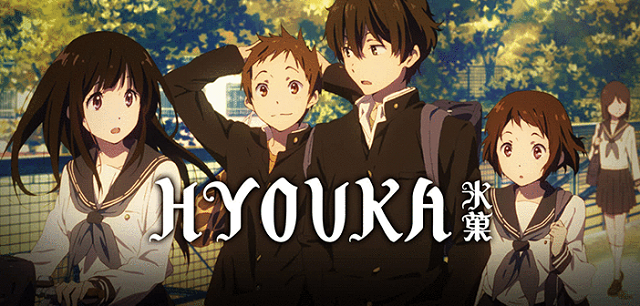
Amun: I’m not sure I’ve experienced the absolute misery of waiting for a week’s episode of a show like I did at the onset of Hyouka’s mystery arc. Beautifully animated, brilliantly written, with characters either blinding or blatantly dull, Hyouka captures the spirit of youth’s most trivial escapades and the overwhelming importance we felt during them. This is not a show you should think too hard about, this is not science – Hyouka is here to make you feel alive, just as Chitanda’s eyes sparkled. Without a doubt, Hyouka’s narrative style and characterization influenced this decade’s drama anime, and it absolutely must be included in any such list.
Armitage: Every anime studio has an image they carry with the very mention of their name. An image that comes as a representation of the kind of anime they make – their most immediately recognizable work. Madhouse has Hunter x Hunter 2011, A1 Pictures has SAO, Bones has FMAB (or the more recent HeroAca). But for KyoAni, it’s difficult to pinpoint that one show which is representative of their distinctive style. Some might argue that it’s K-ON! or Haruhi. The recent anime converts might be fans of Violet Evergarden. But if I had to choose that one series which perfects the KyoAni formula, then I’d say it’s Hyouka. Coming back in 2012, it’s still arguably their best looking show and it is full with everything that makes the studio so beloved. Sparkling doe-eyes, a laid-back slice of life vibe and a catchy enough hook to hold your attention and keep you coming back for more. It’s the one time KyoAni hit a home run in just about every department. Be it pacing, characters, animation or the atmosphere. And even though it’s forever doomed to be in the shadow of the studio’s other popular shows, the people who love it, do so with all their heart.
#39: Haikyuu!!
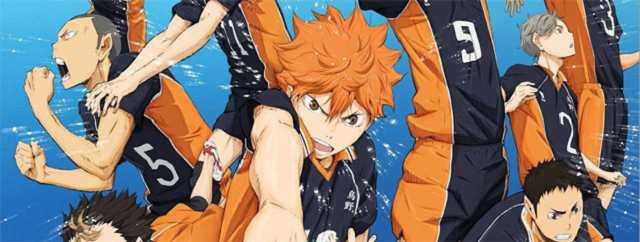
Lenlo: Haikyuu is the embodiment of what a sports shounen can and should be. The last time I enjoyed a purely competition/sports focused series this much was Hajime no Ippo, the series that all but perfected it. Haikyuu’s pacing is spot on, the rivals are built up, fought, and kept around long after their specific arc is done, and the characters are all just joys to experience. Everything from Hinata’s slow growth or Tsukki’s growing love of the game to Oikawa desperately holding back talented players or Ushijima’s denial of everything Hinata is. With Haikyuu every match is an experience, its own minor narrative within the greater story, whether it be Asahi vs Date Tech or Kageyama vs Oikawa. Haikyuu does exactly what Ippo does, layering every match so that it becomes its own little event rather than just a bump on the road to some championship, and I love it.
Wooper: The 2010s are the decade where sports anime left behind their simple “page to screen” philosophy and aimed higher than ever before. Haikyuu is the perfect embodiment of that skyward gaze, both literally and figuratively. The show is all about grasping at something just out of reach: hitting the next centimeter on your vertical leap, surpassing your rival and becoming the ace of your team, perfecting a new skill that’s been eluding you for weeks. In Haikyuu’s case, those payoffs hit so hard because the animation underlines them so strongly. Emotional fist pumps after crucial blocks, wild and sketchy art during breakthrough spikes, diving saves and mad dashes across the court – this show makes volleyball look like the highest-octane game in the world. It might not be the best sports anime in recent years, but its position as the most popular one is well-deserved.
#38: Death Parade
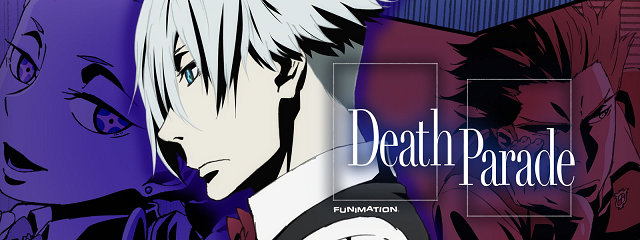
Armitage: If there existed an award for the most original anime of the decade, it’d be awarded to Death Parade. Director and Writer Yuzuru Tachikawa’s lovechild, Death Parade tried to balance themes of good versus evil and the philosophical nature of the afterlife, while serving as a chilling reminder that sometimes good people hide unimaginable darkness within their hearts, and the ones led astray might still be redeemed. What started off as an episodic case-of-the-week series turned into a poignant, reflective rumination on letting go of your past and coming to terms with the fact that we may not always get closure we seek, and that sometimes you’ve got no choice but to live with your regrets. The stories told by Death Parade aren’t of people who are wholly good or bad. They’re just people. Broken, selfish, flawed, kind. Just people.
Aidan: If you have read my blogging of this series you would know that I believe it to be half great and I stick by that. Death Parade has an opening that is truly hard to skip and a setup rife with potential. It didn’t always live up to that potential, but when it reached it then it was truly excellent. It wasn’t my choice to put it on this list and I certainly could think of better candidates, however in a sea of uninspired concepts this is most certainly a standout title. If a second season was ever made it could truly be something magnificent. I would also recommend Death Billiards, the OVA that spawned this series, as it is great. Even after seeing many shows I can still recall the dead eyed bartender of Quindecim and the weird and grim afterlife he inhabits.
#37: Nagi no Asukara
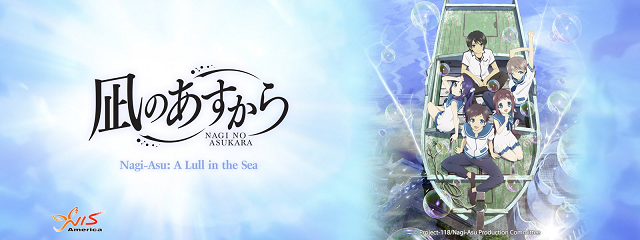
Armitage: Marketed as a love-octagon with pretty backgrounds, Nagi no Asukara shies away from being a gimmicky, convoluted love story and instead tries to underline issues of relevance that hold back every modern society. Racism, prejudice and the inability of people to look past the beliefs passed on to them over previous generations, are all highlighted through motifs and presented in an accessible, relatable package. Yes, it is a story about love but not just the romantic kind. Nagi no Asukara teaches us that it’s important to have love and compassion in our heart for everyone around us and more importantly, for ourselves. Because if we are not going to love who we are, no one else is going to come and do it for us.
Helghast: Animated by PA Works, Nagi no Asukara follows a group of middle schoolers as they transfer to a dry land school when their own one, located in the underwater village, is forced to close due to a lack of attendance. While the visuals and setting suggests a slice of life type of show, it is an engaging and emotional drama about kids coming to terms with their feelings and relationships. This is very much a Mari Okada story, as its 26 episode runtime is filled with love triangles left, right and center, teenage angst and a supernatural element thrown in. The art is what stands out from this show as well as some very serious permanent ramifications that completely alter the tone.
#36: Your Name.
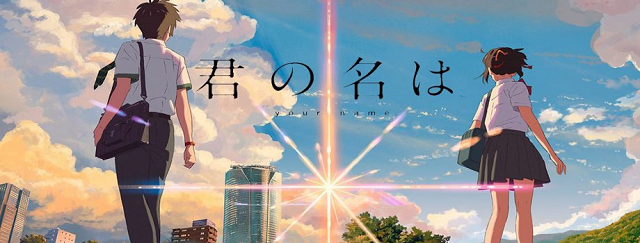
Wooper: Rather than list Your Name’s box office figures or award show accolades, I’ll give you a personal anecdote. I saw this film in theaters with my brother, whose connection to anime is about as deep as your average Naruto episode, and he was actually excited to see it based on word of mouth. That’s the kind of power this movie had, and it wasn’t just based on marketing; the film is gorgeously arranged and animated, and features one of Makoto Shinkai’s best tales of star-crossed love. Taki and Mitsuha take both logical and emotional steps in trying to meet one another, to the point that their body-swapping and time-leaping journeys progress without so much as a hiccup. Both characters are far more active than Shinkai’s typical protagonists, too, resulting in a story you can truly get lost in. It’s not the best anime film of the last ten years, but it’s closer than the naysayers would have you believe.
Helghast: I knew of Makoto Shinkai’s work ever since his Byousoku 5 Centimeter film in 2007 and and even went deep into his earlier stuff of Other Worlds (1999) and Voices of a Distant Star (2002). His style of background art is utterly beautiful with an emphasis on photorealism and how the light plays with it. However, the stories that he tells tend to revolve around the same themes of love, distance and communication. In this 2016 movie, I felt that he was able to create a wildly successful mainstream movie composed of the best elements from his previous efforts akin to a Shinkai’s greatest hits. While Your Name didn’t resonate with me the most out of all his works, it was still damn entertaining, cross-cultural and had an ending that finally broke the cycle of blue balling the audience.
#35: Redline
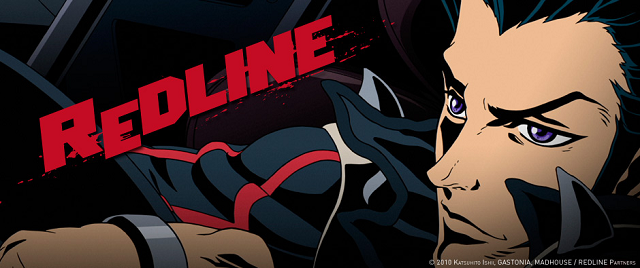
Aidan: What happens when you take Madhouse animators and have them put a decade of work into a story that can be boiled down to “wacky anime races”? Well the end result is Radline, otherwise known as visual cocaine. Every frame, every motion, every non sequitur and minor detail is a visual sensation of wonder. Story? Who cares. Characters? Yeah they are there. A small plot involving political mishaps and gangster race fixing? Sorry, I missed it due to looking at the pretty colours. When you watch Redline you sit down, you shut off and just watch. This movie truly shows that pure style can carry a story, and when you start watching you won’t be able to look away for a moment.
Wooper: Redline is the coolest, most stylish anime film ever made. The plot is just an excuse to string together a series of reality-warping races on alien planets, which will have you gripping your armrests as though you’re the one driving. It’s got a slick-talking pompadoured leading man, a sexy love interest and rival, and a host of diverse alien characters, each of whom were paid just as much attention and care as the stars. Given the movie’s striking, heavily shadowed design work and largely inhuman cast, it’s amazing how alive Redline feels. Even its legendary production cycle can hardly explain the film’s commitment to motion. Its second act puts fewer intergalactic hot rods on screen than the others, but there’s always something to attract your eye, which explains why the movie maintains its momentum so expertly. Is the story a bit unwieldy? Yeah, it is. But when your film looks and feels this good, that’s an insignificant price to pay.
#34: Kill la Kill
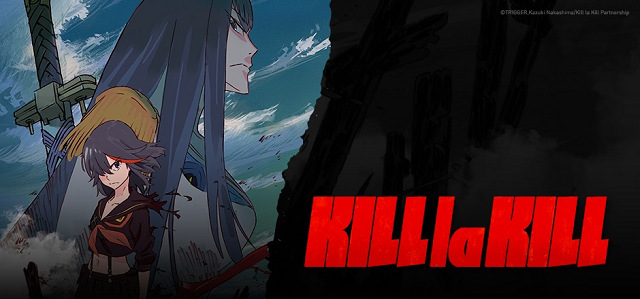
Helghast: I put this as my number one show of the decade so it pains me to see it all the way down here in the rankings. When I really got into anime back in 2013, I came across Panty and Stocking from Studio Gainax and was dejected that there would be very little chance of a season two given that Imaishi split off into his own studio of Trigger. Little did I know that Trigger’s first real TV show would become my favorite and highest rated show of the decade. Ryouko and Satsuki constitute some of the strongest female characters I have ever seen in an anime in a show that is already filled to the brim with testosterone aggression. Sawano’s soundtrack is still as amazing as it was when first aired and the animation is an unhindered wild beast that doesn’t care about conventions. It weaves in all these cultural references and themes that only add to the ridiculous action warranting multiple viewings. Kill la Kill is a show where fanservice is plot, style is substance and every episode plays out like the finale. This is anime.
Lenlo: Kill la Kill was the first Trigger show I ever watched, and it took me 3 viewings and 7 years to finish it. The first time, I tried it when it first came out, and dropped it after the first episode. I just couldn’t get into the style. The second time came 3 years later, when everyone around me was hyping it up and wouldn’t shut up about it. I dropped it after the egregious fanservice. The third time though… The third time was early last year, where at the pestering of a friend I sat down and finished the whole thing. And I loved it. For some reason, the absurdity of it all clicked, I no longer cared that the narrative or characters were ridiculous. This time I figured out the fanservice’s meaning in all of the plot and while I was still eh on it, it wasn’t just to titillate. This time… this time I appreciated the production, the animation, Sawano’s bombastic soundtrack. It may have taken a few tries, and it still won’t be for everyone, but Kill la Kill finally wooed me and I am glad to see it on this list.
#33: Girls und Panzer
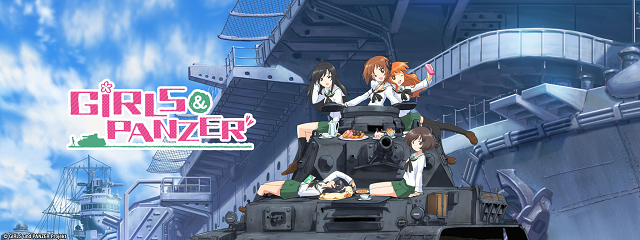
Helghast: Something that I loathe more than standard sports anime is cute girls doing cute things. However if that cute thing is crewing WW2 era tanks and slamming rounds into the opposing team, I’m down for it. Its strong point is that the show is always focused on tankery matches between the various schools that are based on a particular nation and their style of armored warfare. If you like cute girls, then this is one series that actually has a sense of progress to go along with its slice of tankery life. For history buffs and armored vehicle enthusiasts, the attention to detail and the continual introductions to new tanks and tactics will keep them drawn in. Did I mention that all these different high schools sail around on their own mega aircraft carriers? Sadly, the release of new content has slowed to a glacial pace for new animated features, but I’m pretty happy with the current offerings on the market, as they wrap up the core story of saving Oarai High School from closure.
Aidan: It’s high school girls having giant tank battles. I am not really sure how else I can talk that up. Look, it’s a show where driving tanks is apparently the most womanly thing you can do and an underdog story about a small school taking on the big league schools from around the world. With goddamn tanks. There is no underlying metaphor nor complex symbolism. There is no allusion to the metaphysical condition of human existence. There are just girls doing cute things while shooting each other with tanks. And sometimes in life, that’s all you need.
#32: The Disappearance of Haruhi Suzumiya
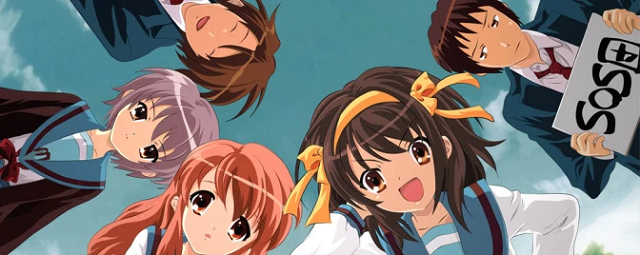
Aidan: The star of Haruhi has faded, much to the fault of a second season teased too far and the worst filler arc in anime history. After season two many didn’t have much hope or excitement for this movie, which they had previously anticipated for years. So it’s a bit of a surprise that this movie was everything we wanted and more. The emotional highs this movie reached were of a kind rare to many a show, with no explosions or dramatic end of the world choices, nor the loss of a loved one or an epic quest. No, this was gravitas created by a single choice, a choice that would redefine everything Kyon believed and finally reach a truth sorely missing from the original series. And every second a lovingly animated serenade. This may be the last we ever see of Haruhi and looking at the books after this I know that nothing will quite match this in quality. But if this is the end of Haruhi forevermore then this may be the most perfect way it could have left the stage.
Mario: I consider Disappearance (along with Adolescence of Utena, for opposite reasons) one of the best anime franchise movies I’ve seen. As devoted a Haruhi fan as I am, I never considered the series that deep – not until this film, that is. Disappearance shines because it adds some extra layers that the show lacks, digs deeper into its themes, and adds character developments – huge developments – to Kyon and some other members of the club. When the ending hits, it hits real hard and KyoAni adapts it with their top-notch production. Shy Yuki is an excellent character for this arc (she doesn’t deserve a whole series though) and many people consider the movie to have justified the whole series. I’m not going that far, but this arc is one of Haruhi’s best and it’s proof that Haruhi still has plenty of good material left. I won’t back down on supporting the new season of Haruhi.
#31: Chihayafuru
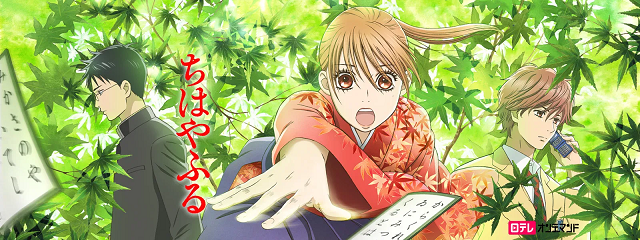
Wooper: Chihayafuru has the hook of an after-school club show, the structure of a sports anime, the design work of a shoujo series, and the occasional flourishes of a slow-burning romance. Most fans will tell you that the characters are the series’ strongest asset, and they’re not wrong; Chihaya’s unwavering devotion to karuta transforms everyone around her, and all of those transformations are worth watching on their own. As for my favorite part of the show, it would have to be the small moments between tournament matches. As a competitive card game player myself, those pre-tourney catch-up sessions and hopes for favorable matchups ring true. Without those quieter, more ordinary moments, the free-flowing tears and slapping of tatami mats wouldn’t have the same impact. For me, Chihayafuru is a series that hits all the right notes in depicting the lives of both competitors and friends.
Armitage: Chihayafuru is a show with multiple tournament arcs lined up one after the other and the necessary breather moments scattered throughout, to keep things from feeling stale. On paper, it seems like an anime about a Japanese card game but somehow, at its core, it is not a story about the sport of karuta. It’s a story about change. About growing up. About trying to be a better person than you currently are. About letting go of your failures and moving forward. The relationship at the centre of the show appears to be a typical love triangle between Chihaya, Taichi and Arata and to be fair, the heart of this story is indeed their growth and interaction. But the soul is the development of the side characters, who go from one-note stereotypical archetypes to becoming flawed yet relatable people. And that’s what makes Chiihayafuru stand out from other sports anime of its ilk. The amount of love and care with which it presents its characters. It’s a true gem of the medium and I am so very glad that I gave this story a chance.
#30: Night is Short, Walk on Girl
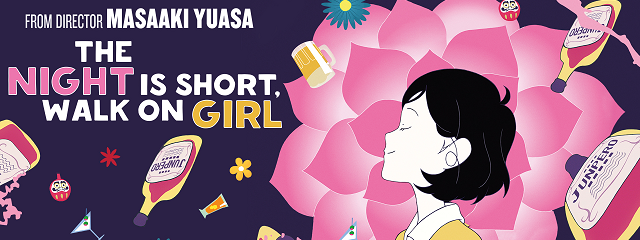
Mario: I still consider Night is Short as THE best anime film of the last ten years, and that says a lot in a decade where The Wind Rises and Your Name were also released. Everything that I have come to love about anime and what the medium does to push boundaries are all there. From the experimental but fluid and expressive visual style of Yuasa, to the wild, messy writing style of Tomihiko that somehow comes together in the end, to the love for its magical-realist take on Kyoto (which I found to be my favorite city ever), every aspect of this film screams “creative” and resonates with me on a personal level. I can feel the love brimming through every second of the film, through every character and through every line they speak. Night is Short is another worthy addition to an already impressive body of work of the legendary director Masaaki Yuasa.
Lenlo: Unlike a lot of the other writers here, I am not a movie guy. I don’t watch many of them, anime or otherwise, and I rarely go to the theaters. I am even less of a BD guy, only owning 10 total at the moment. And yet, Night is Short, Walk on Girl managed to worm its way into both of those selective groups. I love everything about it, from Yuasa’s unique style he originally used for Tatami Galaxy to its almost Disney esque magical night on the town in Kyoto. And similar to my favorite animated film of all time, Tokyo Godfathers, Nigh is Short has something for everyone. It’s a movie you can watch when you want to relax, or you want something philosophical or silly, or what have you. Based on how you are feeling when you watch it, you will get something different from it, making it infinitely rewatchable. And to me, that’s one of the best things a film can possibly be.
#29: Monogatari Series
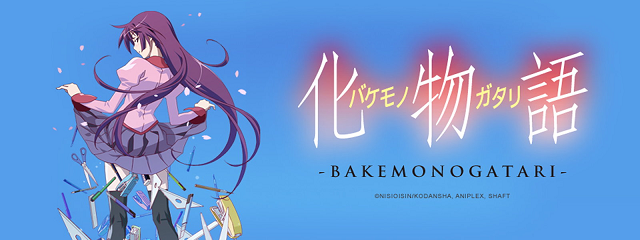
Mario: I am a fan of Monogatari and yet it still baffles me how popular the whole franchise is in anime fandom. For one, Monogatari Series’ style is extreme. It utilizes abstraction, it relies on unconventional visual quirks and it goes on and on with the dialogue and fanservice. If you consider Bakemonogatari and Nise as introduction arcs, the second season serves as its middle chapter where various cast members face and overcome their own issues. The decision to tell these arcs away from Araragi’s perspective strengthens the narrative; the second season has much less annoying fanservice, and other cast members literally have their own voice and spotlight to grow. While Bake starts off in 2009, the rest of the show – 100 plus episodes – detail all the ups and downs and the growth of Araragi and an entire cast, hence it deserves to be in my own top spot for the decade list. For me, Monogatari Series is an experience unlike any other, and these characters feel like friends that I have grown up with.
Lenlo: I have a complicated relationship with the Monogatari series. The first time I watched Bakemonogatari, I hated it. Even on rewatch, I think Snail is one of the worst arcs of the series and that Bake is subpar. And yet the further I got into it, the more I wanted to watch. Even through the arcs I detested such as Sodachi’s or Nadeko’s, I wanted to watch more. Because the highs, the Hitagi End’s, the Tsuhiki Phoenix’s, the Tsubasa Tiger’s? Those were worth it. Those were fantastic. Those were arcs deserving of being mentioned, even if it means taking the Tsukimonogatari and Koyomimonogatari with it. I know this doesn’t sound like a congratulatory “Anime of the Decade ” description, but as a Monogatari convert who started the series hating it and ended the series quite liking it, I can only say this: Give it a shot. I promise you, you will find at least one arc that speaks to you.
#28: Hellsing Ultimate
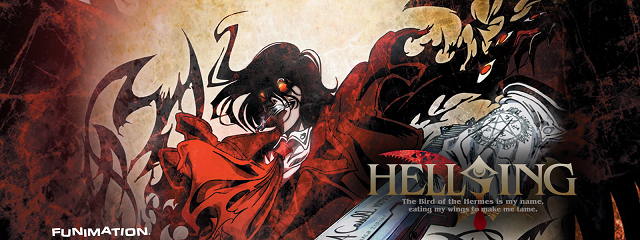
Armitage: Zombie Neo-nazis led by the modern embodiment of Hitler vs a blood-thirsty immortal vampire and a badass knife-wielding priest. To top it off, arguably the most proficient dub cast in any anime. Hmm. This sounds like such a tough sell! I mean, seriously, the only way that you won’t get something enjoyable out of Hellsing Ultimate is if you are a bit squeamish and hate the sight of blood even in its animated form, or are under the age of 12 or just hate the very idea of having fun. If you aren’t someone who belongs to either of these categories, are just looking to have a good time and want to watch some nazi guts being torn apart… re-stock your popcorn reserves and load up the first episode of Hellsing Ultimate. Thank me later.
Helghast: Like FMA: Brotherhood, this ten part OVA from Studios Madhouse, Satelight and Graphinica is the full adaptation of the source manga that a previous attempt wasn’t able to finish. Having a release schedule that spanned six years, it was everything that fans of the manga ever wanted. With the exception of the music (the 2001 version had the superior soundtrack), it had the all violence, overzealous Catholics, nazi vampires and insane characters that only an anime could provide. It also gave us one of the best abridged series that does just as good of a job in telling the same story with more memes, raunchy humor and far tighter pacing.
#27: Shiki
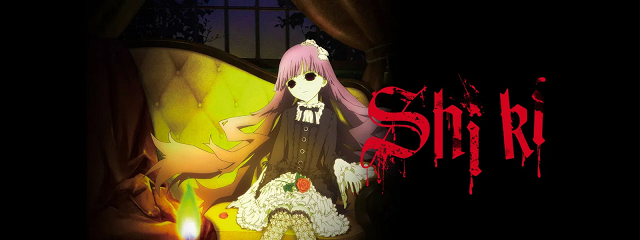
Mario: Shiki does justice to the whole horror anime genre. The pacing might appear slow at first, but Shiki spends that time to produce an atmosphere full of dread and decay. You can see it everywhere, from the small, isolated town in fear of vanishing, to the people who turn into Shiki and lastly, to the remaining humans who become increasingly desensitized to taking lives. That sense of decaying, in turn, allows Shiki to tackle the heart of morality and mortality. Through a diverse cast on both sides who all have their own significant roles in the story, Shiki portrays the vampire’s side to be just as vulnerable, and sometimes as humane, as their human counterparts. The show hits hard then, given how it refuses to sympathize with either side as their acts of violence become more aggressive. Death serves as a central theme in Shiki, both literally and figuratively, since death can be seen as rebirth, and as a means to address the purpose of living. Shiki is not for everyone. It demands and challenges viewers, but for those who are patient enough, the ride is rewarding.
Aidan: Shiki is a slow burn of a series that I wouldn’t likely consider for this list for its first half, which is indeed a slow setup that can be frustrating to some. But that second half is filled with a dramatic hubris that I adore with all my heart and soul. This is a story about monsters – monsters that drink your blood while you sleep and monsters that arise when the perfect scapegoat for cathartic violence appears. Where there is no true good or evil, but two sides that cannot abide the existence of the other. Mutually assured destruction being determined be it of the body or soul. Leaving behind only those who have lost and couldn’t have done anything to stop it. The ending is sardonic and so beautifully nihilistic that it still sticks in my mind after all these years. The first half may be a bit of a slog but the payoff makes it all worth it, with its message that true evil is not realising just how monstrous you have become.
#26: Saga of Tanya the Evil
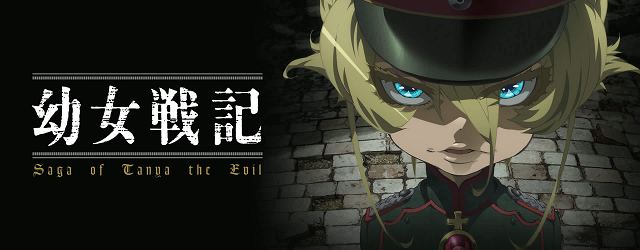
Helghast: I hate the isekai genre. I hate all of its stupid tropes, OP characters, busty sexy companions and overused fanstasy settings. It is an absolute cancer infecting the current landscape of anime right now. Youjo Senki is none of those things and I love every single moment of it. Studio Nut even consciously changed the character design of one of its more shoujo-looking characters into a dopey horse. Taking place in an gritty alternate history of World War One, its sociopathic protagonist is more of a villain than her Overlord counterpart will ever be. It’s so refreshingly heartwarming to see someone express their intentions with violence, speed and momentum.
Aidan: In an age of tired isekai, it’s truly something when one decides to work within that genre and not take the generic Dragon Quest fantasy world, but instead use it as a means of telling alternative history. Tanya couples comedic misunderstandings with the existential struggle against of force of seemingly omnipotent prowess, and just how twisted a human can become under the right circumstances. Interesting historical details can be devised from the setting and the concept of a little girl becoming the working backbone of international conflict will always remain interesting. My only wish is that we can see the finale of this ridiculous tale and just how monstrous Tanya can truly become.
#25: After the Rain
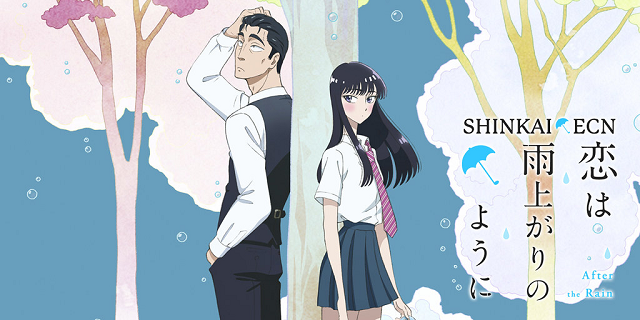
Lenlo: For anyone who knows me, reads my reviews or has been around the site for any length of time, you know I don’t tend to like romance or slice of life. Often they are trite, dull or just poorly made. However, After the Rain is none of these things. It never feels like a simple rom-com or drama, but more like a well-rounded story that dips its toes into everything. In a lot of ways this makes it hard to classify, but maybe that is part of why I enjoy it so much. Built around its core cast of Akira and Kondou, After the Rain drags you in early by your heartstrings and never lets go. Yet instead of dragging it out forever with the perpetual “Will they won’t they”, After the Rain gives us actual progress throughout its run, which is more than most romances can say. It turns into an easily followable and enjoyable story rather than a torrid soap opera drama. So suffice to say, if you are anything like me and don’t normally enjoy romance series, give this one a shot. It may change your mind a bit.
Wooper: After the Rain features a lot of great dramatic moments, but its repertoire is bigger than just one genre. Comedy, romance, and slice-of-life passages are threaded through its short 12-episode run, which creates a sense of depth that’s rarely found in other single cour series. Take manager Kondou’s humorous misunderstandings, for example. Though they’re very funny, they also mask the self-deprecating spirit of a man who has given up on his dream. Yet as the show progresses, his contemplation of pursuing that dream again in middle age gains more gravity. Supporting cast members play a comparatively smaller role, but their romantic successes and interpersonal struggles keep the series grounded in a world that is sometimes inviting and sometimes harsh – just like the reality it closely captures. It’s the presence of these other elements that make After the Rain an eminently followable drama, rather than one that leaves you on the edge of your seat.
#24: JoJo’s Bizarre Adventure
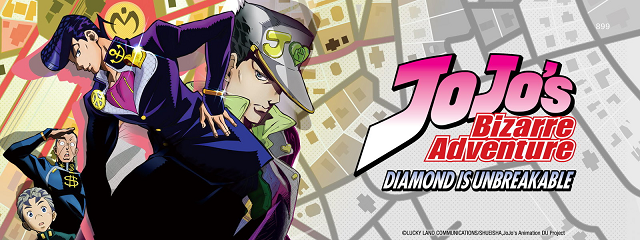
Aidan: Describing the appeal of JoJo’s is akin to describing colours to a blind man. If I were to judge it only on the storytelling then I could say it comes up short, but I personally prefer to set aside its long legacy and what it inspired, as I feel that is irrelevant to the appreciation of the show itself. To me, JoJo’s is a time capsule of the eras. Every part is a representation of the tropes and standards of the time, for as JoJo’s parts travel decades at a time, so too does the writing, music and the truly bizarre nature of the encounters. From Victorian vampires and robot nazis, to time-stopping egotists and bomb crazy serial killers. At first the series is charming for its antiquity, but then as Araki grows stronger as a writer, it becomes less of a meme and more something worth emotional investment. Watching JoJo’s is like time traveling through the ages of anime and doing it with style.
Mario: JoJo’s Bizarre Adventure is ridiculous, but deliciously so. This modern adaptation takes the right fighting spirit from the manga and dials it up to 11 with its psychedelic colors, larger than life characters and addictive soundtrack. It’s the campiest and most meme-ified adrenaline head rush available. The main appeal of this show is to see how it tops itself, so to judge this show in regards to its plot progression or anything “deep” is irrelevant. What I appreciate the most is that JoJo doesn’t take itself very seriously (or perhaps it takes itself TOO seriously) and just enjoys the ride and makes some noise. It has a sense of style like no other, and for that it’s a glaring example of a “cool” show that done absolutely right.
#23: Space Dandy
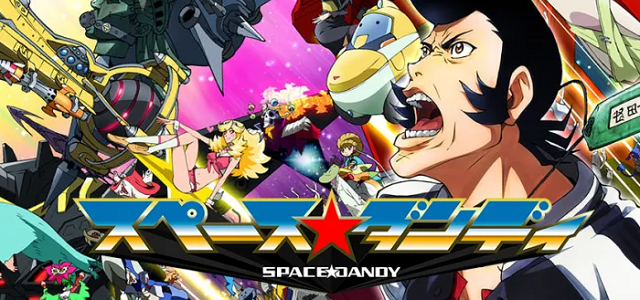
Wooper: Space Dandy is one of anime’s greatest experiments. 20 different directors worked on this series, each of whom were allowed to design their episodes from the ground up. The result was a series full of genre send-ups and wildly different art styles, with eye-popping animation to be found in nearly every installment. There are zombie viruses, space races, sentient plants, trips to purgatory, and interdimensional love stories – and that’s just scratching the surface. Most sakuga nerds will tell you that Space Dandy is among the most impressive TV productions of the decade, but there’s an element of the show that I feel has historically been underrated, and that’s the character of Dandy himself. As a being who exists in all universes simultaneously, he’s the perfect glue to hold these disparate adventures together. Often hilarious, sometimes poignant, and always entertaining, Space Dandy is proof that creative freedom can yield tremendous results.
Helghast: Space Dandy: he’s a dandy guy in space. It’s also one of the most inconsistently consistent shows that I have ever experienced. Conjured up by Shinichirō Watanabe (Cowboy Bebop and Zankyou no Terror), it’s less of a typical anime project and more of a showcase for guest directors to do what they want with its three main characters. Highlights include reuniting a small alien girl with her grandfather, a race that is reminiscent of Redline and a psychedelic acid-trip on Planet Limbo. While some episodes didn’t have that much of an impact on me, a majority of them were wild rides that had me marvelling at how they executed each concept from week to week. Studio Bones deserves some props for being able to animate every guest’s director style, like Masaaki Yuasa’s unique aesthetic, and blowing much of their budget on the finale like a boss.
#22: Beastars
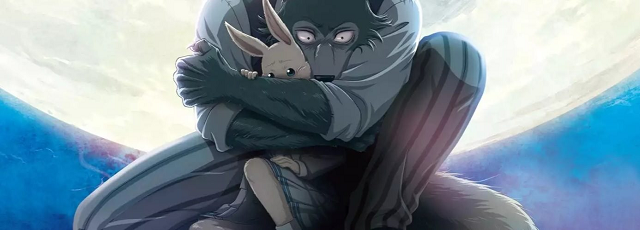
Mario: For me, Beastars is at its heart a Greek melodrama about two star-crossed individuals who are not meant to be together. The fact that the show coats that theme with an anthropomorphic world full of carnivores and herbivores is just the icing on top. The worldbuilding is refreshing with its own laws and rules of thumb, and through that the show boasts an engaging protagonist who has fought through his hunting instinct with his feeling of love. Legosi’s complex struggle to make sense of his feelings is well-articulated and believable. Studio Orange did a magnificent job at adapting it, and again proved that CG anime can be great if they don’t try to mimic the traditional hand drawn style. There are many iconic moments in this first season, and like Vinland Saga, it feels more like a prologue for an epic story to come. Here’s a toast to a job well done, and let’s all look forward to the second season.
Amun: Beastars, at first glance, was CG furry fodder in a high school setting. Looking back on the first season, that proved a grave miscategorization. Romeo and Juliet comparisons are nice and all, but Beastars ups the ante with less teenage romance and more “will Romeo eat Juliet?” Beastars’ position on this list is also more than just the main duo: the exquisite world, the brilliantly done “gimmick” (herbivores and carnivores must learn to coexist in modern society), and a phenomenal supporting cast all elevate this show from a niche audience to something with universal appeal and message. To me, that’s not just entertainment – that’s art.
#21: Cross Game
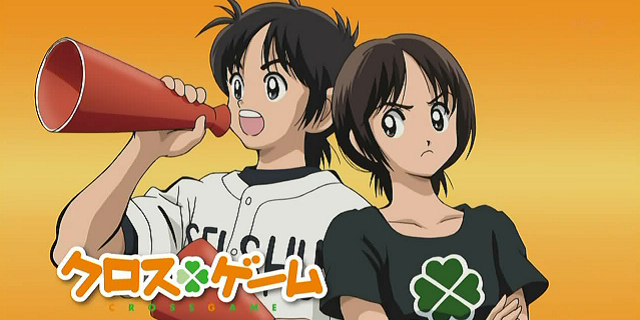
Wooper: Cross Game’s legendary first episode is a one-two punch of nostalgia and pathos that instantly situates the viewer within the show’s world. Anyone who watches it is guaranteed to be struck not only by the show’s clear vision, but also by the way the series carries its themes forward as it progresses. There aren’t any flashy fights or beautiful backgrounds on display here, but Cross Game does offer superlative character writing, making it ‘real’ in a way that busier, more expensive-looking anime could never be. It’s sad enough to give you chest pain, and clever like an offhand comment from your funniest friend. The lives of its cast members are intertwined in small ways, but the show puts them under a powerful microscope, enabling us to feel what they feel without ever doubting their authenticity. It’s a great story from start to finish, and a testament to the importance of naturalism in fiction.
Mario: Cross Game grabs your heart right in the first episode and never lets go for the entirety of its run. Adachi might be accused of doing the same things over and over, but with his mastery of character writing, pacing and affecting moments that tug your heartstrings, there’s truly nothing to fault him for here. Unlike any other sports show where the sport is the main focus, in Cross Game it’s the characters that drive the story, and the chemistry they produce and the depth in their characterization are something special that you don’t see very often in this medium. It’s natural, subtle, complex, intimate but reflects very well to their emotional development. Cross Game is the opposite of a showy anime; it’s understated and subtle in every aspect, but you can feel the lasting impact when all these pieces fit together just right.
#20: Usagi Drop
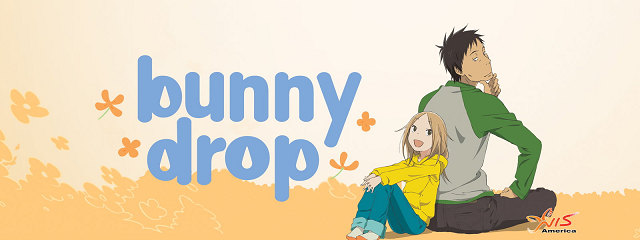
Mario: The topic of raising a child is rare in anime, and to be as good and realistic as Usagi Drop is nothing short of extraordinary. It takes two complete strangers starting on a new phase of their lives together to highlight what parenting and childcare are really like. While I have some minor qualms about Usagi Drop such as its inconclusive ending and rarely-mentioned financial situation, those complaints are quickly tossed aside compared to the show’s strengths. The main weapon of Usagi Drop is the solid dynamic of Daikichi and Rin – two lovely individuals in their own right – as we witness how they begin to trust each other and enjoy their time together. In addition, Usagi Drop is adept at depicting how Daikichi evolves as a father figure. He sacrifices many things so that it can work out better for him and Rin. This show is a celebration of parenting, and to watch Rin and Daikichi go through day-to-day life together is an experience to be cherished.
Amun: Usagi Drop warms your heart. With simple drawings, simple premise, but a powerful story, Usagi Drop teaches us that family is what you make it. Thrust into a difficult setting, both adult and child try their best to overcome the situation that neither asked for and neither are responsible for…but both try to fix. Daikichi’s growth as a parent is embodied by Rin’s physical and emotional progression, with the viewers cheering along every step of the way. When it comes to anime that give you hope for humanity and a smile on your face, Usagi Drop is my de facto standard.
#19: Re: Zero
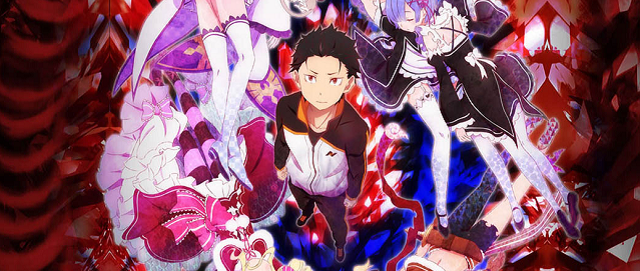
Aidan: Re: Zero continues to have a polarising status within the community and does appear to be a “love it or hate it” affair. Considering its position on this list you will likely know what category I stand on, and if it was up to me it would have been higher. Quite frankly this series was one of the most engaging experiences with anime I have had in a very long time. To any who would dismiss it as just another isekai, I would sorely recommend that you think otherwise. The amount of love put into the production of this series is astounding, so much so that director’s cuts of it are being released as we speak. I consider episode fifteen to be legendary, with many likely feeling the same about episode eighteen, as well. While other isekais focus on making the protagonist feel special, this one continues to punish the selfish mentality of a youth till the point that they learn to mature and truly care about those around them. With its sequel coming up in April I would like to think that its reputation will become better, as it is no longer just a prologue of things never to come. But even without that, this is one hell of a ride.
Amun: I was fortunate enough to see the premiere of Re:Zero in Japan (thankfully they used fairly simple words in the first episode) – I was hooked from the onset. No discussion of the now prevalent “isekai” genre can ignore Re:Zero – it may not have been the first, but it put the genre on the map. With clearly defined weaknesses and a realistic portrayal of the PTSD that would have occurred in its plot, Re:Zero feels believable – this is what would happen if a loser high schooler was really thrust into this situation. You struggle along with Subaru, grinding out every step, facing every bitter disappointment, then start again. It’s painful, it’s agonizing, but when success is finally tasted it’s so sweet. With a second season looming and the franchise looking strong, I expect great things in this upcoming decade as well.
#18: Shirobako
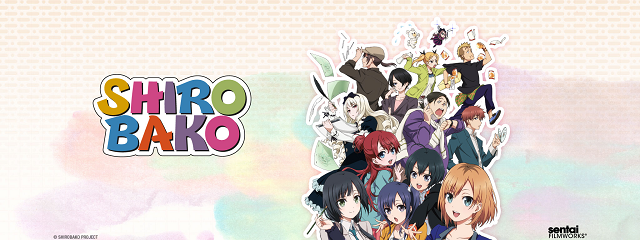
Wooper: Shirobako is the show that educated a huge number of western anime fans, myself included, on the production methods used to assemble their favorite Japanese cartoons. Its scripts were packed with terminology that sent me on a Googling spree back in 2014, leading to my discovery of Anipages and transforming my appreciation for anime into something greater. But the series isn’t just illuminative – it’s also a great workplace dramedy. The friendships, conflicts, and breakthroughs within the show are balanced with a keen eye for character progression, and as a result, it only gets better throughout its run. Animators from different generations inspire each other, production assistants support one another, and creators in different fields come to respect new techniques and viewpoints. That’s the sort of world that this series envisions, and while the modern anime industry might not reflect those ideals, Shirobako makes you believe that one day it could.
Lenlo: Shirobako did for the anime industry what Fune wo Amu did for dictionaries. It took a field that most people either don’t know or don’t care about the details of, and made them interesting. It gave viewers a human connection to something they had only ever seen the product of, letting them sympathize with Aoi and her workload as a production assistant. Or Ema’s road as an animator, learning from and being inspired by her co-workers, practicing new things for her art. All the while giving us an appreciation for the old guard and how difficult seeming “manager” positions can be, from the stress and deadlines placed on them to the consequences of working with a client. Even idealized as it is, this is the best look into the anime industry Western fans have ever really gotten, and it opened a lot of doors. Letting people know that yes, people care, people are interested in the industry. Looking at it like that, it’s easy to see why Shirobako placed as it did on this list.
#17: Houseki no Kuni

Mario: Make no mistake, Houseki no Kuni is one the most ambitious anime projects of this decade. Not only because it’s one of the shining examples of a CG show done right, but also because its narrative scope is at once strange, grand and beautiful. This season feels more like an introduction to an epic story than anything else, but at its core Houseki serves as a coming of age story for our protagonist Phos, while exploring the insecurities of the other characters towards their own roles. Houseki the anime approaches the source in the best way it possibly can: by highlighting the unique appeal of its gemstone cast with striking visual metaphors and dynamic fight sequences. It both respects the core themes that make the manga stand out and maintains its own vibrant personality. Unique, strange, beautiful, devastating, ambiguous, and charming all at once, Houseki is an one-of-a-kind series, and I mean that in the best possible way.
Lenlo: For a studio that has only made two series on its own, not including contract work, Orange is currently batting 100 for this list, and it all started with Houseki. At the time, and even now really, Houseki was a marvel of CGI. When everyone else was playing with Berserk 2016 or Knights of Sidonia, Orange was proving to the world that it can work. That a pure CGI anime can not only look good, but even become critically acclaimed, proving that it is not the CGI that holds a series back – just the ones using it. And the best part about Houseki is that even if you take away the stellar production and animation, it still holds up. The story, one of loss and growth, self-discovery and actualization, works regardless of the medium. I can’t say that Houseki’s production didn’t influence how much I like the series – that would be a lie, I love its production – but I can say for sure it’s not the only reason.
#16: 3-gatsu no Lion

Wooper: When 3-gatsu was announced as a Studio Shaft series in 2016, there was weeping and gnashing of teeth within some sectors of its fanbase. What would such an off-the-wall studio do, they wondered, with such a sensitive ensemble drama? As it turned out, the answer was “faithfully adapt a wonderful story, chapter by chapter.” In fact, 3-gatsu’s directorial quirks are so restrained that the show’s emotions are painful to watch at times. Depression, abandonment, bullying, and loss plague its cast. They’re driven to scream their frustration at times, but some are more likely to lie in bed long after the sun has risen, or quietly push themselves through crushing pain. 44 episodes is plenty of time for recovery, however, and 3-gatsu demonstrates great compassion by bringing its damaged characters together to form makeshift families. Rei and the Kawamoto sisters have one of the warmest and most tender relationships of any anime series I can recall. Come for the sadness, stay for the healing; 3-gatsu has it all.
Mario: 3-gatsu no Lion is, simply put, one of the best character pieces this medium has to offer. The show can be dark and depressing at times, but it’s also a compassionate show, in the sense that it’s concerned about the characters’ struggles and loves them because of it, because it understands that insecurities and flaws make up who they are. The love for its characters spreads out not only to the core cast, but to all the supporting characters, some of them from the shogi world, and others from Rei’s personal life. Shaft’s direction also heightens the dramatic sequences with sharp visual symbolism, although that style doesn’t lend itself well to the comedic bits. 3-gatsu no Lion is a statement that unhappiness is OK. Being depressed, unsatisfied or stressed does not make you weak – it makes you human. More than any other show in this top 50, 3-gatsu is one of those shows that will stay with me for years to come.
#15: Shinsekai yori
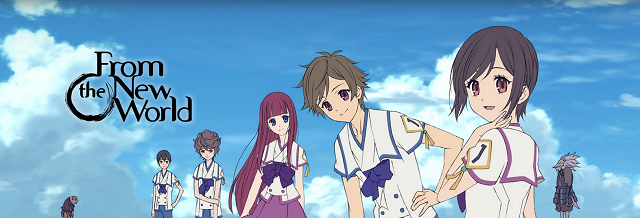
Lenlo: Every time I look back on Shinsekai yori I come away with something different. Sometimes I look at it and see a troubled production, with inconsistencies throughout. Other times I will see the occasionally troubling depictions of gay relationships as a “phase” and what not. Yet more often than not, I come away with and remember it for its themes of human connection. Of humanity’s ability for both cruelty and kindness, of the dangers and appeals of certain forms of government. Of how we treat and often times marginalize our fellow humans, seeing them as lesser, and the tragic tales of children caught up in it all. Shinsekai yori is one of those series, similar to Serial Experiments Lain, that I did not come away “enjoying” in the traditional sense. But it is definitely one I will remember for a long time to come.
Wooper: As a work of animation, Shinsekai yori falters here and there. Its character designs are off-putting, and its meandering art style doesn’t always capture the show’s oppressive atmosphere. As a work of speculative fiction, however, it has very few peers, even on a list like this one. The further into the future you travel as a writer, the harder it is to keep your story plausible, but Shinsekai yori stays grounded by exploring the potential and the cruelty of human beings. The war-torn history and fearful traditions it creates are bleakly fascinating reminders of our lesser nature, which emphasizes survival over all else. Even if you put humanity aside, the evolution of Earth’s topography and animal life receive plenty of attention, and the show goes to some frightening places in its quest to depict those changes. This is the kind of anime that actively challenges your conception of how the world works, and how it may work 1000 years from now.
#14: Psycho-Pass (Season 1)
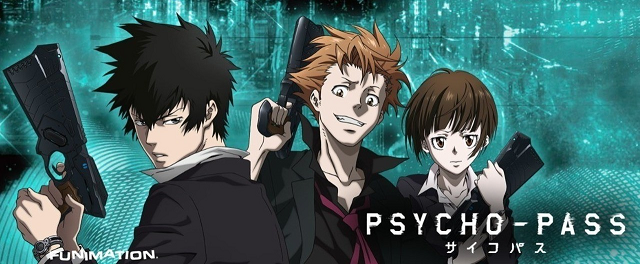
Armitage: How do you define evil? If someone is born to be a killer, is it their fault that people end up dying by their hands? If it is, then is it justified to eliminate such a threat the moment that they are born? If killing one person and killing one hundred both lead to the convinct getting the death penalty, are the two deeds equally evil? These are all difficult questions and Psycho-Pass is a show which realizes that. It doesn’t try to give easy answers but instead puts a far more relevant question in front of the viewer. “What would you do?” It’s a story that understands that morality isn’t a concept with universally acceptable definition. What may be less of a crime for you might be unforgivable for me. Writer Gen Urobuchi tells a story where there are no black and white themes but instead, everything is shrouded by a lot of grey. Murky, tenebrous grey. It urges the viewers to try and come to conclusions of their own. To question their own beliefs. To agree or disagree. Because if you’re really a part of society, it’s something that’s always asked of you.
Helghast: Ghost in the Shell offerings in the past decade have been mediocre compared to its 1995 movie adaptation and the Stand Alone Complex TV series of the 2000s. Thankfully, Psycho-Pass has stepped up to the plate with its Minority Report-inspired future of Japan. Featuring characters from Gen Urobuchi and high quality visuals from Production IG, its mature storyline and fanasticing antagonist really explores a society that has given itself over to the Sibyl System. With the exception of its terrible second season, every single animated movie or series has been quite good in quality. Rolling into the new decade, Psycho-Pass still has a bright future ahead for itself.
#13: The Tatami Galaxy
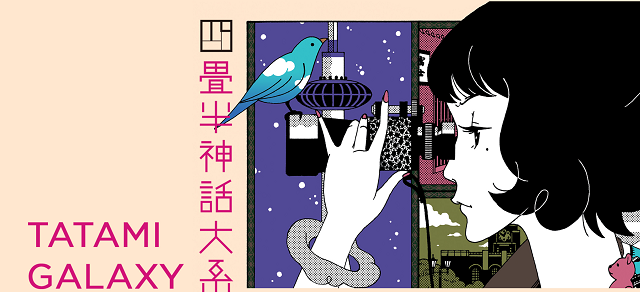
Lenlo: Like a lot of Yuasa’s work, there is nothing quite like Tatami Galaxy, at least nothing that isn’t directed by Yuasa himself. The pacing is fast, the dialogue breakneck and the episodes gone in a flash. Yet each episode builds upon the same core cast of characters, adding layer upon layer with every story. Eventually each one becomes, in their own extreme way, a reflection of a real person, of someone we know. Whether it be the person you love, the trouble maker or the wise senior, each one is just an exaggerated real life person. Their thoughts, histories, aspirations, all of them are explored across Tatami Galaxy’s 11 episode run, culminating in those characters finally breaking through this repeating cycle of episodes into the future. Just like Yuasa’s other work on this list, Ping Pong, I could gush about Tatami Galaxy for hours on end. So instead let me leave you with a personal anecdote. I first watched this series in college, just like the lead. And Tatami Galaxy, over its 11 episode run, completely changed my college experience. Getting me to go out to clubs, meet people, and experience my “rose colored campus life”. It wasn’t perfect, it wasn’t dreamy. But it was mine and it was real, and I have this show to thank for that.
Mario: The Tatami Galaxy is a brainchild between one of the great masters of storytelling Tomihiko Morimi (The Eccentric Family; Night is Short, Walk on Girl) and the great master of visual art Masaaki Yuasa. The Tatami Galaxy builds its story around the concept of multiple paths of choice from the same situation. The artistic style is loose and stylized but always expressive. Each story works as a standalone wacky tale, but they ultimately serve as just one shade of the protagonist’s colorful college life. The overloaded use of color and the unstoppable run of the narrative are both integral parts of the story. Each character, though some of them might appear quirky and whimsical at first, all offer different tones and multiple sides to them as these stories unfold. Creating such a chaotic yet organic universe that successfully speaks about how to live your life to the fullest itself is a rare and wonderful thing.
#12: Mushishi Zoku Shou
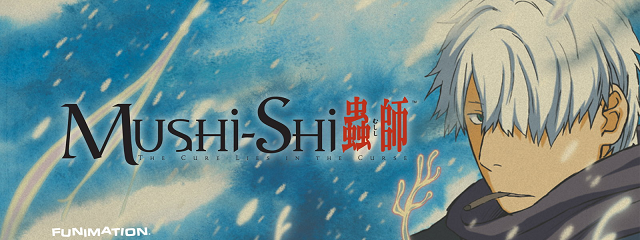
Mario: If I have an adjective to describe what Mushishi is, it’s “otherworldly”. Mushishi is a singular experience that you don’t see anywhere else, let alone in this anime medium. Mushishi’s episodic tales have always resonated deeply with me, and I find myself thinking about them a lot. It’s haunting, it’s like a meditation about humanity and life in general. Mushishi’s core belief is that all lives are interconnected and we humans are just a small part of this ecosystem, but these small lives matter. All its self-contained stories focus squarely on the human side and how they deal with mushi and their lives with themes such as grief, longing, and loneliness. In that sense, Mushishi is one of the most humane shows on this list. Its mastery of sounds, visuals and storytelling mark it one of the most unique experiences you will ever have. Mushishi is truly a work of great art.
Wooper: Mushishi is often assigned labels such as “soothing” or “healing,” but to me, watching the show is a contemplative experience. Its background art may be lush, and its soundtrack ensnaring, but these are just components of the series’ atmosphere, not the main draw. So what is it that makes Mushishi special, more than anything else? Simply put, it’s human relationships. Husbands and wives, parents and children, siblings, lovers, friends and enemies – these are the main players in Mushishi, not traveling doctors or ethereal organisms. A whole spectrum of raw emotions are displayed across the series’ 2014 revival, sometimes ending with understanding and reconciliation, and other times with unthawed grief. Either way, the show never fails to create authentic human relationships, and mine them for everything they’re worth. If there’s anything that’s comforting about Mushishi, it’s that we can see our lives reflected in its stories, and know that we are not alone.
#11: One Punch Man (Season 1)
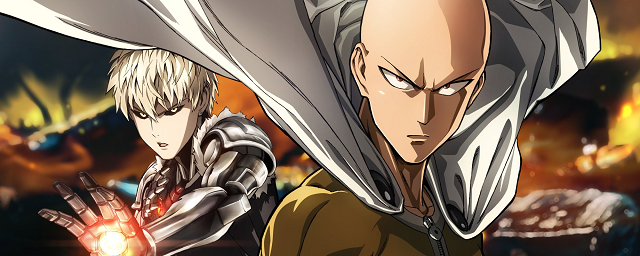
Aidan: If Ufotable set the standard of what digital effects can do for anime and Orange set the standard which CGI anime must now live up to, then One Punch Man was the reminder of just what spectacular visual wonders a person with a pencil can conjure up. Storywise, One Punch Man was a fun romp about the meaninglessness of absolute power and the ridiculous nature of superheroes while packing its own heartfelt core that can be applied to any average Joe. What set it apart is the amount of love it was given to make every punch an explosive knockout of visual splendor and make the comedy work so well. If anything its second season is evidence of what happens when that passion is lost and how soulless and frustrating a story can become without its shine. However, season one will always stand as a great standalone showcase of just what can make animation so special, along with encouraging others to up their game.
Lenlo: HYYYYYYYYPE! That’s right, I’ll be the shounen degenerate this time. I love One Punch Man for a very simple reason: It’s fun. Yes, you can dive into it as a satirical take on comic books and superheroes as a concept. How it pokes fun at the silliness of its general shounen structure, the ludicrous nature of tests that aren’t equipped to grade someone different or the clever gag comedy strewn throughout. If you want to look deeper, it’s all there. But whether you care about that or not, One Punch Man is based on a very simple idea: Hype. Hype fights, hype animation, hype OST (God that OP), you name it and One Punch Man has a hype version of it. At its core this series is one of fun and joy, both for the viewer and clearly the animators, who were let loose to do what they wanted, giving us one of the greatest showcases of action animation this decade. And if you want more, there is always something there for you to find in ONE’s honestly ridiculous number of references. Just watch it and have a good time. That’s my rec.
#10: Attack on Titan
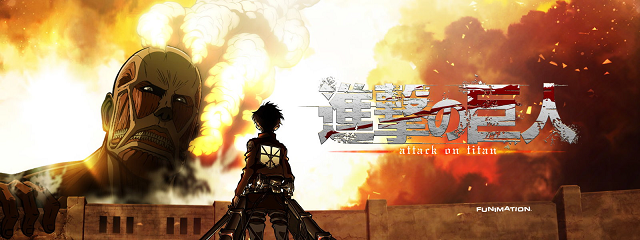
Amun: As I’ve written elsewhere, Attack on Titan needs no introduction. One of the marquee franchises of this decade, the Scouts’ exploits, victories, and tragedies have thrilled a global audience and shaped the very medium of anime. No longer are early 2000s levels of action and stakes acceptable – the majority of today’s fantasy anime strive for bigger impacts, bloodier fights than they would have – I would say – due to AoT. With humanity’s epic struggle on display (and some mind-blowing twists along the way), Attack on Titans’ cast, world, animation, and Mikasa (very important) have elevated an entire genre and thrilled an entire generation.
Armitage: In retrospection, the 2010s as a decade would be remembered for the phenomena which took over various pop media. There were the Marvel Movies, TV had Game of Thrones and anime had Attack on Titan. The prime catalyst because of which our medium came close to becoming mainstream, back in 2013, and the entry-point for so many modern anime fans, Attack on Titan was billed as an edge-of-the-seat thriller where all characters were devoid of plot armor. And those who were sucked in by the buzz quickly lost interest by the time the second season rolled in and the show shifted gears to become the story Hajime Isayama always intended to tell. These very people missed out on some of the most jaw-dropping set-pieces and the most cathartic payoffs the medium of anime as a whole has to offer. And if you are up-to-date with the manga, you know that the best part of the story is yet to come. And that’s the only reason Attack on Titan is this low in the list. As of now, it is THE story that defined anime in the 2010s but by the time it finishes, it might end up setting a new standard for the ambitions that stories in any medium will have to try and emulate.
#9: Fate/Zero and Fate/Stay Night
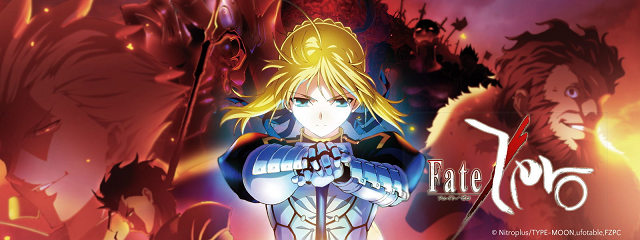
Aidan: Look if one of these didn’t get on the list then I would have fixed the site. That’s no lie. I am a Fate fanatic so of course I am not only going to call these anime the best thing since sliced bread but also better than sliced bread. It’s a series about historical legends battling each other to the death with underlying philosophical themes about what truly makes a hero, coupled with some of the best animated fight scenes in the medium. Whatever your stance, be you Fate/Zero only or a lover of both, it is undeniable how much the franchise has grown from humble beginnings. And with the eternal money maker that is Fate GO, there is much more to come (for better or worse).
Helghast: Fate at the beginning of the last decade was simply a cult-favorite visual novel with an average adaptation from Studio Deen. It is now a multi-billion dollar franchise that just keeps printing out cash and churning out animated products like there’s no tomorrow. While most of the Fate entries from this decade range from being just okay to great, the standouts of Ufotable’s adaptations of Fate/Zero, Unlimited Blade Works and Heaven’s Feel are technical masterpieces and offer the best that the franchise has to give. UBW and HF are the gold standard of what an anime adaptation should be, faithfully adapting all the relevant plot points and adding a ton of flair to deep mythos of the Holy Grail War. Meanwhile, Fate/Zero is the fully realized battle-royale of mages and servants fighting together and against each other in a dark and depressing prologue to the original VN.
#8: Mob Psycho 100

Wooper: Mob Psycho 100 is a modern miracle of animated storytelling. It’s blessed with fight scenes that set a new standard for the action genre, for more reasons than the sheer number of drawings per episode. The show’s effects work in particular, both with visuals and sound, sucks you in to each of its many combat sequences. When you combine that attention to detail with mid-fight perspective switches and Kenji Kawai’s psychedelic soundtrack, you have an all-time classic on your hands. Much has been written elsewhere about Mob’s search for purpose, his kindness despite his overwhelming power, and Reigen’s dual nature as a caring conman, and the characters are a crucial part of the package, to be sure. But for me, it’s all about the production, which probably won’t be topped until we’re well into the 2020s.
Lenlo: What is there to say that Wooper didn’t say above? Do I talk about how Mob Psycho 100 is beautifully animated, covering numerous different mediums and styles, letting each animator really put their personal touch into it? The amazing OST, filled with iconic tracks from the obvious in the Mob Choir OP to the battle tunes of “Mobu Chikara no Kaihou” and “Mob Kanjou no Bakuhatsu”? How about the fun and engaging characters of Mob and Reigen, creating a paranormal buddy-cop duo in a coming of age story about ghosts and middle school? It took me weeks to figure out just what to write here because I had no idea where to even begin and so little space to gush. Suffice to say, Mob Psycho 100 is a stellar production the likes of which we rarely see in anime, and it easily earns its spot on this list.
#7: Made in Abyss
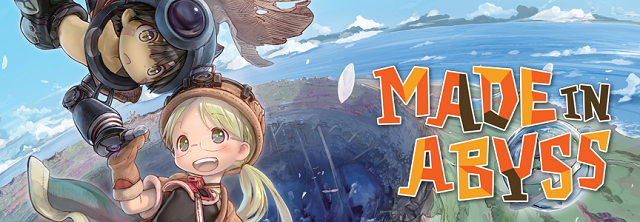
Helghast: Every once in a while, an anime comes out that transcends the medium and captures its audience in an enthralling journey into the unknown. Telling a story about a little girl and her robot friend going on a one-way sucide mission into a cavernous hole to find her mother, this whole world feels like a complete package that has its inhabitants and culture steeped in the lore surrounding the Abyss. I usually don’t hold manga adaptations in high regard but the source material is an exceptional piece of work that has lavish backgrounds, an unworldly setting and doesn’t hold back any punches. With Studio Ghibli veterans crafting the background art, Kevin Penkin’s God-tier soundtrack, and Kinema Citrus making all the right directorial moves, the adaptation only builds on that foundation through its ability to elicit emotions ranging from tension, joy and utter heartbreak through its thirteen episode run. Starting off the new decade with Dawn of the Deep Soul, a movie that adapts the best arc from the manga, and another sequel project in the works, it rumbles on as a triumph of scientific excellence.
Aidan: You likely have seen many a story about children wandering into dark and mythical fantasy realms to learn life lessons and mature past adolescence. But I sincerely doubt you will encounter a story as brutally unforgiving as Made in Abyss. For it shows exactly the result you get when children walk into an unforgiving dog eat dog world. Though weak in the middle, none can fault this anime for excellent world building, stunning background design, evocative emotional music and dramatic gut punches that still hit just as hard two years later.
#6: Puella Magi Madoka Magica
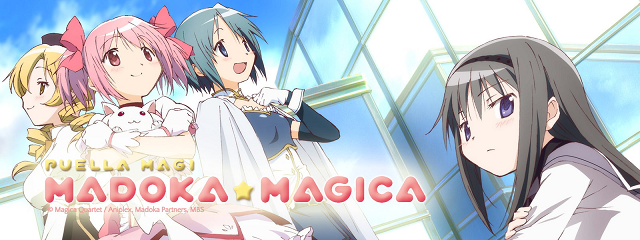
Helghast: Madoka did to the magical girl genre what Evangelion did to mecha by starting off a trend of edgy and dark shows in their respective genres. With the script being penned by Gen Urobuchi, the plot cleverly subverts the tropes of a classic genre that tends to be bright and optimistic about overcoming the monster of the week. Incorporating the superflat style of Akiyuki Shinbo (Zetsubou Sensei and Monogatari) along with Yuki Kajiura’s soundtrack, it is a psychedelic experience that sometimes borders on the abstract but makes the entire experience even better when it comes to its conclusion. Outside of its 2013 movie Rebellion, which flipped the TV series upside down, there hasn’t been a true sequel which is a shame in itself, as I would have loved to see its overarching story come full circle.
Mario: One of the most influential anime of the decade, the high point of both Gen Urobuchi and Shaft, and the prime example when people talk about “dark mahou shoujo” or “anime deconstruction”, Madoka Magica certainly stands the test of time. As with many of Gen Urobuchi’s shows, the moral is grey and ambiguous. The show constantly keeps us at the edge of our seats and the main characters go through a lot of suffering, but this suffering is in service of its provocative themes. The cost is that many of them feel more like vehicles for the plot than real people, especially Madoka’s character. From a production standpoint, it’s one of the rare cases where the quirky visual style of Shaft falls in line with the context of the show, such as the cut-out animated styles in the witch battles. Overall, Madoka Magica is neatly constructed and deliberately paced, keeping enough twists to keep it engaging, while smart enough to never descend into pure shock value.
#5: Fullmetal Alchemist Brotherhood
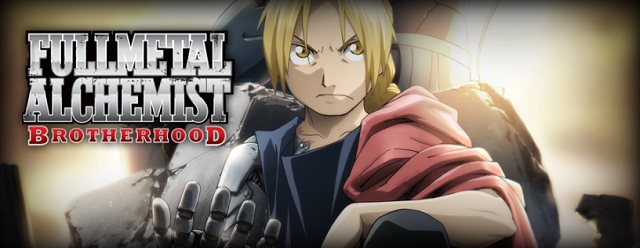
Lenlo: Where do you even begin when describing the Shounen that influenced two whole decades of media? 2003 was already good, even when it went anime original. Yet Brotherhood returned to complete the original story and give us some of anime’s most iconic characters and moments. From Scar to Mustang to Greed to the Elrics, FMA:B is top quality shounen all the way down. Every part of its world and narrative bleeds detail. From the hard magic system of alchemy, its clearly defined constraints in modern science, to the geopolitical landscape that is Amestris, Drachma and Ishval. The rich history of these nations informs the overall plot of the series and the ultimate plans of the villains. All the while wrapped in some of the best production Bones has ever overseen, even 10 years on. Personally, I don’t think perfection exists, it’s unattainable. But in the world of shounen, nothing has come as close to it as FMA:B.
Wooper: FMA is such a staple of the average anime fan’s diet that it’s difficult to remember just how creative it is. The series’ version of alchemy ranks among shounen anime’s best combat systems, providing the foundation for dozens of creative fights. It also pulls double duty as a key component of the show’s philosophy, which celebrates self-sacrifice and self-betterment in equivalent measure. Creating villains from the seven deadly sins is nothing revolutionary, but the homunculi’s all-black outfits and ouroboros tattoos became iconic for their sheer coolness. In terms of production, Brotherhood still feels forward-thinking despite being ten years old. Employing a brush pen style during moments of particular intensity was a stroke of genius, and one that set the stage for Bones’ more daring experiments as the decade continued. Fullmetal Alchemist’s position here is more than a legacy vote – it’s a recognition of how consistently good its ideas and execution were, and still are today.
#4: Steins;Gate

Mario: One of the most critically acclaimed shows of this decade, Steins;Gate offers a refreshing depiction of time-travelling and a thoughtful case study of a man who experiences it. Steins;Gate explores the possibilities of multiple time-lines and how small changes from the past could lead to completely different outcomes in the future. On top of that, it’s the human drama that makes this show so gripping, thrilling and ultimately rewarding. The show, however, suffers when it leans towards its visual novel conventions, most notably the side characters as they fall into typical tropes, and the comedy is weak compared to its compelling drama. Even with those issues though, Steins;Gate is easily one of the better science fiction anime in recent memory, if not the very best.
Armitage: In the Spring of 2011, I was introduced to MADOU SCIENTISTU, Houin Kyouma and the goofy group of misfits which formed his research team. Now, it wasn’t love at first sight. I knew how time travel worked and had seen it being used in interesting ways before. So, for the first-half of the anime I was entertained but a little disappointed. “Is this it?”, I remember thinking. And then, episode 12 happened and I got it back. That feeling I had missed for so very long. That adrenaline rush. By the time episode 24 ended, I was head over heels. Because I had seen something I didn’t think was possible: The anime equivalent of watching a Nolan Film. Featuring everything including the death of the main love-interest (not a spoiler) and time-travel and all. I don’t think there can be a better sales pitch than that.
#3: Ping Pong the Animation
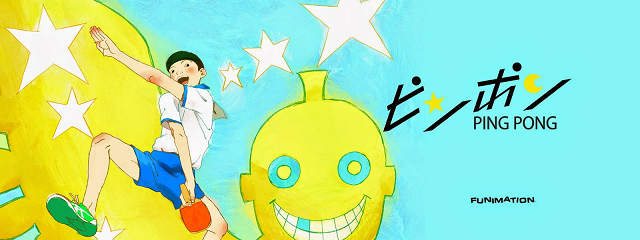
Lenlo: You would think that with Ping Pong being my favorite anime not just of the decade, but all time, this would be easy to write. But really it just leaves me with no idea where to start. How about Yuasa’s distinctive visual style and incredible use of Flash animation, creating something wholly unique? Or how Ping Pong embodies the essence of sports and coming of age series, with a cast of incredibly well realized characters? Each one deals with very real problems from personal motivation to not being good enough at what you love, to even just the idea of family and belonging. Or even just Kensuke Ushio’s OST, a one of a kind record of electronic music. If I had 5,000 words and an entire review, I still couldn’t do this series justice, not to my satisfaction at least. Not to mention a single 200 word blurb on a list of 50 entries. So instead let me end on this: If you watch nothing else, if you had to listen to a single opinion of mine or care a whit for my thoughts on something, watch Ping Pong. Please.
Wooper: Despite its difficult production schedule, Ping Pong bears the mark of love that all great series do. Its excellence is most clearly seen in the struggles and triumphs of its high school heroes, who ride the line between despair and exhilaration every time they pick up a paddle. Their desires and fears are expertly realized by the show’s use of Flash animation and split-screen shots. Masaaki Yuasa and his crack team of episode directors gave distinctive, impossible styles of movement to each athlete, as befit their personalities. The soundtrack, too, uses driving electronic rhythms to propel its audience directly into the psyches of the people on screen. It’s one of my favorites of all time, anime or otherwise. If you think Ping Pong is ugly, you’re not wrong – but stay until the credits roll, and you’ll witness its characters rise to truly beautiful heights.
#2: Shouwa Genroku Rakugo Shinjuu

Armitage: Here’s the thing. As anime fans, we are constantly seeking that one masterpiece whose praises we can sing aloud to every non-believer. But because of the state of the present-day anime landscape, the shows being produced take less risks and try and incorporate as many popular trends as possible, no matter how beaten to death they may be. And to find an anime like Rakugo Shinjuu which is on the exact opposite end of the mainstream spectrum is a minor miracle in itself. Now, I can wax poetic about all the aspects of the show which make it the masterpiece that it is, from the minimalistic direction to the MAGNIFICENT voice acting (Ishida Akira as Kikuhiko is the best performance by any seiyuu in all of anime. Hands down.) but I fear that I would still sell it short. All I can say is that if you had to take something from my contribution to this AOTD list, take this: If you plan to watch one anime from this Top 50 list, only one, then please just watch Shouwa Genroku Rakugo Shinjuu.
Aidan: Before this show I had no idea what Rakugo was. Now I know and have profound respect for the artform, but to say the show is only that would be a disservice. For Rakugo is a show about people and how an artform can define them. It’s amazing the efforts the voice actors bring to this show, as it requires them to play in a very particular way: a voice actor slowly maturing and improving over time, even intentionally messing up and making it seem natural. I do feel that it suffers from a bit too much focus on its main character and an epilogue that went on a bit too long, but the emotional drama reached by these stage actors puts a near supernatural enchantment on their performances. For a show about storytellers acting out roles with nothing but their mannerisms and voice, it really shows just what little is needed to engage people in a fable.
#1: Hunter x Hunter (2011)
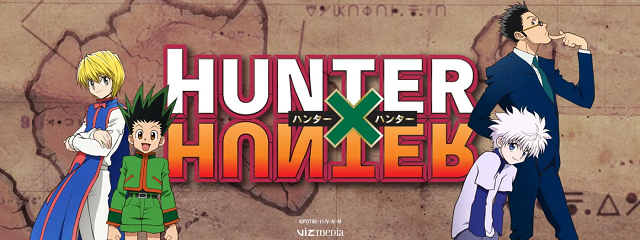
Amun: Here we are: the peak of the decade’s anime. The pinnacle. Appearing on six out of seven ballots, Hunter x Hunter broke out from among the crowd to reign supreme, and for good reason. No other anime of recent memory created such a vibrant and dynamic world as HxH. Flat protagonist, bordering on OP? Character creep like never been seen before? Creepy, perv clowns? Paper problems that would have sunk any lesser anime were brushed off by Gon and company as they set off on the quest to be the best. But Hunter x Hunter isn’t just boyhood escapism – mature topics such as romance, gruesome violence, revenge, and family dynamics all come into play. The concluding arc is about rigging an election for goodness’ sakes. Sitting atop many anime of all time lists (mine included), Hunter x Hunter is a masterpiece that is often emulated but will never be replaced.
Armitage: When we talk about Hunter x Hunter 2011, your relative hate or adoration of it comes right down to the Chimera Ant Arc. A 64-episode behemoth and longer than most anime, Chimera Ant Arc is where author Yoshihiro Togashi decided to fully utilize the reputation he had built up as one of the most prominent mangaka in Japan and not just break the norms of shounen manga but reinvent storytelling as a whole. Narrating minute long battles across multiple chapters, building up to climaxes but never providing expected payoffs and turning the fist-pumping ‘super-saiyan’ moment into a grotesque nightmare, Togashi delivered a story, which like all great tales which get etched in our memory, was at its core, a love story. And the likes of which we might never be able to witness ever again. Hunter x Hunter 2011 is the once-in-a-generation experience that transcends the very medium of anime and sheds its shounen roots to become something entirely incomparable and I am so glad that I had the good fortune of being an anime fan when it aired.

Its good to see your opinions laid out.
Although I may have included all of Ikuhara’s work this decade, Devilman for another Yuasa choice, for Okada I may have put Anohana or Horou musuko.
Glad to see Girls last tour, houseki, girls und panzer, made in abyss, hellsing and Shiki get attention. Sangatsu is a top 10 for me.
I am a filthy filthy unwashed heathen that while I like Mushishi, I prefer Natsume.
Tsuki ga kirei was the surprise of the decade for me.
It is unfortunate that I’m not into many of the shounen stuff listed and I’ll never be a convert to Nasu, Urobuchi, Isshin or Shinkai’s work.
I fall firmly into the hate camps for Shinsekai yori and rezero.
I never liked Haruhi all that much when it aired and Konotsuba was something I really wanted to like but always left me cold, its like I NEED to find someday when I’m in the mood for it where it’ll click.
I’ll have to watch Shirobako someday and get around to it and finish space dandy.
The only omission that made me tear-up was flipflappers .
Kaguuya on the list instead of Muh Hi score girl.
I’d have fit fruits basket and banana fish on somewhere 😉
Sounds like your preferences line up most closely with Mario’s – he had both Hourou Musuko and Flip Flappers on his ballot, plus all three Ikuhara shows.
This is a great time to watch Shirobako, as its sequel film is releasing in Japan in just a few days. English speakers probably won’t get it until early 2021, but at least if you watch the TV show now, you won’t be waiting half a decade for the movie.
I tanked Ikuhara’s works so hard, I detest most of them. So sorry there.
For Okada, I did enjoy Anohana.
I fought valiantly for Anohana to be included in the Top 50. But the board was spilt and it barely missed out.
Also, I hard agree that Sangatsu should be in the overall Top 10. It was in my personal Top 3. And it really hurts to see (lesser and somewhat undeserving) stuff like Fate and OPM above it. 🙁
Just want to quickly add for anyone reading, I’m not trying to start an argument/be contrarian/troll with mention my dislike of those popular names, I know people do do that to annoy fans, but i’m not, its my genuine viewpoint.
Nah we get ya. I myself had issues, for instance the only parts of Jojo I think are good are Part’s 2 and 4, meanwhile for Monogatari I am in a love hate relationship with it. I love some arcs and detest many others (Like Bake).
So its all good. We assumed there would be contention, but it was a fun project between all of us and everyone got somethin they liked on the list in the end.
Sounds a bit like my confused relationship with trigger, from a cinematic point of view and outside some of the action bits Gridmann caught on with me eventually and I had fun with promare, but I watched kill la kill and especially Lagann at the height of popularity and couldn’t finish either.
I am the only person on earth that isn’t a fan of Madoka Magica.
Great effort putting this together, seems I have a lot to check out as I’ve only watched 4.5 shows on this list! (the half is because I’ve only seen the first season of Space Dandy so far).
Kyousougiga and Flip Flappers are two shows I would have included; Mobile Suit Gundam Iron Blooded Orphans as well although I’m pretty sure you didn’t cover that show.
I know Mario enjoyed Flip Flappers, I believe it appeared on the lists. I think we link to our top 50 ballots to. I recommend you take a look, I a number of things got cut because of universal support on others.
Well, Flip Flappers is in my top 10 of the decade, which baffled all the other writers lol
What a great write up (kudos for avoiding recency bias). I did not see it coming. Just looking at this list and there really has been an absurd amount of great anime and just in the last decade. Us fans of the medium really are spoiled.
Flip Flappers, Kyousougiga … disturbing that they’ve not made it.
But the most criminal – Aku no hana ??? Top 10 for me for sure.
I wish someone made oyasumi punpun & ultra heaven but thats prolly never gonna see the light of the day as anime ~~
Good writeup 🙂 , ive watched almost everything on that list. (sans 3 i think)
All three of those shows were on Mario’s ballot – of the seven of us, he’s the one with the artsiest taste. Maybe check out his individual list (linked in the intro paragraph) if you’re hunting for something new to watch.
47/50 is damn impressive. I hope anime is just as good to you in the upcoming decade as it was in the previous one!
I’d say less of “artsy taste” and more of I enjoy shows that are “over-ambitious”, or you could even say, “pretentious” 🙂
Thanks for this! My watchlist has been running empty lately so a list like this will be very useful. I’ve seen most of the entries on your list (41/50), and although I probably won’t watch all of the missing titles (Silver Spoon and Tsuritama will probably get on my nerves for their romanticization of practices – animal farming and fishing – I’m not fond of, and I’ve always avoided Nagi no Asukara because of its supposed involvement of tons of romantic melodrama, which I detest), some of them (like Shiki, Space Dandy and Cross Game) sound like series I should like – and should probably have tried long ago.
As for my own preferences, my highest rated series that didn’t make it to the list is Katanagatari (although Mario also awarded it a top ranking). For me Katanagatari is like a better version of Monogatari: it’s just as stylish (if not more so), has a stronger cast (Monogatari’s cast is a bit too tropeish for my taste, even if it does subvert those tropes to some extent), and where Monogatari overstayed its welcome for me (to the point where I still haven’t seen the epilogue movie because I’m just that tired of the franchise) and had some very low lows to go along with its highs, Katanagatari was consistently great and had a very tight focus.
There are some other series I’d have also definitely put in my list (Kaze ga, The Eccentric Family, Bloom into You, Hinamatsuri…), and many others I’d have seriously considered (A Place Further Than The Universe, A Silent Voice, Baby Steps, Bakuman, Devilman Crybaby, Die Neue These, Gintama° (Season 4), Hourou Musuko, one or more of the Ikuhara series, Kekkai Sensen (S2), Nichijou, Sound Euphonium (especially S2 and Liz and the Blue Bird), Space Brothers, and some others I probably forgot), but overall it’s a strong list that has something for everyone.
I personally wouldn’t put Hunter x Hunter anywhere near the top spot, though. It’s definitely one of the best battle shounen out there, with some fantastic arcs and terrific climaxes. But it also takes quite a while for it to really get going, some of its arcs are pretty mediocre and even its better arcs (like the Chimera Ant arc) have quite a few dull moments to go along with its great ones. My favorite of the decade (3-gatsu no Lion) made it to #16 of your list, though, so I can’t complain!
I tried to get Kaze Ga or Fune wo Amu on the list, but they just barely fell short at 51 ;_;
Turns out putting it at #7 on my list isn’t enough to force it up.
Fune wo Amu is on there! You even wrote a bit about it. I agree it’s a shame about Kaze ga though, but that’s democracy for ya: you win some, you lose some. 😉
By the way, speaking of sports series that narrowly missed out: what’s the deal with Ginga e Kickoff? I hadn’t ever heard of it, but two of you (Wooper and Armitage) put it in their list so it must be doing something right.
And I’m also curious about Wooper’s competitive card game history! What kind of card game do you compete in, and at what level? Are you aiming for the top like Chihayafuru’s protagonists, or do you just play it casually?
Oh it is. I wrote it so long ago, I forgot. Yaaay!
I’ve been competing in Pokemon TCG tournaments for 15 years. At this point it’s just casual, but during my high school and early college years I was fairly serious, ranking within the top 100 players in North America multiple times. The reason I watched Chihayafuru in the first place was its card game subject matter – my Pokemon phase preceded my anime addiction by a wide margin.
As for Ginga e Kickoff, it’s a kids’ show, but a very good one. A few of the kids on its soccer team get rich, rewarding character arcs that eclipse a lot of the stuff in our joint top 50, IMO. The story and art aren’t fancy in the least, but I love when child characters undergo hard-earned growth, and that’s Ginga e Kickoff’s big strength.
That’s really impressive, I never knew you had that kind of history! That also puts your username in a new perspective, in that it actually reflects a genuine affection for the Pokemon universe.
And thanks for the explanation! I’m generally not a big fan of kids’ shows, but I do really like character-focused sports series, and I heard the MC is pretty original too (in that he’s not very talented as a player but excels at directing other players), which sounds interesting. So I’ll give it a try at some point, and hopefully its first few episodes will be able to win me over then.
@Animosh: a little correction, I put Monogatari series as my top ranking (yeah, detest me all you like), but Katanagatari did end up on my top 10.
There were a 4-way ties for #51, those are Katanagatari, The Eccentric Family, Run with the Wind and Anohana. Amun especially hated Katanagatari though.
Tsuritama remains one of the most “original” anime to me in recent years, if you enjoy Flip Flappers and Kyousougiga, you’ll like this one. For Silver Spoon, I get your concern regarding the topic, but to its defence I can say the show put a lot of thoughts and respect to it. You don’t need to agree with their viewpoints but I suppose you won’t get offensive by its viewpoint either.
Personally, the only complaint I have for this list is the lack of Ghibli’s movies. I had Princess Kaguya near the top and Wooper listed The Wind Rises, but they were the only two votes for Ghibli.
Ah no, I meant “top ranking” as in “very high ranking” (#7 on your list): I knew Monogatari got the first place on your list. And don’t worry, I’m not holding that against you! Despite my criticisms of the series, I think Monogatari does a lot right too (from its complex cast and intriguing themes to its unique style), so I can definitely see why you would give it the top spot.
Pff, so three of my favorites are stuck at #51. 🙁 Oh well, what can you do…
I don’t think I’ll necessarily be offended by the viewpoints of Tsuritama and Silver Spoon (I’m rarely offended by opinions): it’s more a matter of … not finding their premises appealing, I guess? Fishing and animal farming are practices I dislike, so if a series places them at their very center, I’m going to need a very good reason to watch them, and I’m not confident these series’ other aspects will be able to win me over. I may give them a few episodes at some point though, they just won’t be very high on my priority list.
I’m not a big Ghibli fan, but I agree it’s strange there aren’t any Ghibli films on the list. Princess Kaguya is very highly rated – and I remember its animation being gorgeous – so it wouldn’t have been strange to see it here. But with the seasonal cycle it’s always hard for non-franchise movies to get the attention they deserve (and the broad audience they need to make it on these lists), and even more so when they’re a bit older, so I suppose it’s to be expected.
Ginga e Kickoff is soccer done right! Like really really right. I’d even put it above Giant Killing. And if you even remotely enjoy the sports genre, you really owe it to yourself to check it out.
Also, in my humble opinion: Volleyball boys > Running boys.
Thanks for the explanation! I quite liked Giant Killing (with its refreshing focus on professional athletes and football culture, instead of the usual high school club) and I generally find sports series pretty enjoyable (even though I can rarely be bothered to watch a real-life match), so I might check this out.
Haikyuu and Kaze ga are both great: Haikyuu excels in bringing hype and excitement, and Kaze ga has one of the strongest casts (if not the strongest) in sports anime. I rate Kaze ga just a bit higher (though Haikyuu is still ongoing, so who knows, it may surpass it in the end), but both belong in this list imo.
A fairly solid list, and it’s great that you guys enjoy them. Mine would turn out quite different, but yeah, anime had a relatively good decade this time around…barring all the ecchi and isekai stuff that plagued it.
Thanks a lot for the post. As ususal it was a very nice read and, as a sucker for lists myself that made me very happy 🙂
As for myself, my take on the decade would be something like this:
TV series (I consider them separatedly from Movies and Ovas)
1- Shin Sekai Yori: No contest here. The only series of the decade I’d even consider including in my top 10 ever.
2-91 days: The only other 10/10 I’d give to any TV series this decade. Masterful from start to finish.
3- Shiki : Glad it made it into your list. A truly haunting series with one of the best OSTs of the decade
4- Hero Mask: Well, I’ll forever be baffled at the lack of response of the anime fandom with this series. It’s a crying shame though, as it is one of the most gripping sci-fi thrillers I’ve seen in quite a while. As a friend of mine said: If Monster had been a 24 episode sci-fi thriller it would had been called Hero Mask. And if that’s not the biggest compliment you can give to any series I don’t know what it is…
5: Terror in Resonance: By far the best Shinichiro Watanabe series of the decade, ’nuff said.
Honorable mentions: Psycho Pass, Mushishi 2, Death Parade and Book of Bantorra (at the very least, as a tribute to good ol’ Psgels, even though I know he doesn’t care about anime these days… all I can say is that that was the series I discovered when I started reading this blog 10 years ago and it had pretty much everything that made me an anime fan in the first place).
As for Movies, my list would include Genocidal Organ (yep, by now you should realize I’m a sucker for a good sci-fi mystery), Harmony (just like GO, another gem from the woefully underrated Project Itoh movies), Maquia (jus friggin’ beautiful), Giovanni’s Island and the Berserk movie-trilogy.
Overall, while I think this decade had a ton of great series I think there was a lack of true timeless masterpieces compared with the 00’s. I mean, I love all the series listed here but there’s no way in hell any of them (barring SSY) could even compete with stuff like Monster, Gankutsuou or Texhnolyze…
Terror in Resonance is a definite gem, I agree.
I’m quite disappoint Kyousougiga didn’t make it, but over all a good list. I’m just so indifferent with the Hunter x Hunter anime at this point. It would have been an amazing experience to watch HxH be animated properly, yet I really cannot get pass Gon and Killua voices so I couldn’t even finish the first episode. So, it’s nice to see it at the top over something like Steins;Gate but I would be lying if I say I care.
Strange that The Ancient Magus’ Bride isn’t there… just my opinion.
To me, the first half was outstanding. – but the second half kind of fell down into mediocrity.
I was never sure of what Magus bride wanted to do/be, it trips over itself when trying to be a fantasy show and a slice of life all in one and just ends up failing in accomplishing both to me.
Finally got some time to fully read this up. The only anime I would have included are Asobi Asobase, Gundam Unicorn (the only issue is you need some background knoweldege of the earlier installments, but it more than makes up for it), Your Lie in April, The Tale of Princess Kaguya and A silent voice. Maybe HIgh Score Girl too. But of course, this is just me throwing my opinon out there.
Mario and I split our Ghibli votes – he went for Kaguya, I picked The Wind Rises. Had I known this list would end up with no Ghibli films, I’d have just rigged my ballot and picked Kaguya instead. It’s a beautiful film, for sure – just runs too long IMO (at 2 hrs 17 mins).
Personally, I prefer Gundam The Origin to Unicorn due to its tighter story. Unicorn’s fusion of combat and music is incredible, though. I could feel my blood pumping during some fight sequences – and then I felt like going to sleep when the characters talked for too long.
I really think Oregairu should be on this list. It had great character development, and a great blend of comedy and social commentary, plus a realistic look at the “edgy loner” type of teenager. It’s empathetic toward Hikigaya’s loneliness and difficulties with social interaction while still showing how he does need to reach out to people because even though he denies it, he is lonely.
Also, I think you may have just forgotten that it occurred this decade since in aired in 2011, but Mawaru Penguindrum should also be here.
After the voting, Oregairu ended up tied for 55th – four out of seven writers put it on their ballots, but no one ranked it super highly. Call it an honorable mention, I guess?
Mario and I are the only Penguindrum fans on staff, unfortunately. It’s among the boldest TV anime of this decade, but boldness doesn’t always result in audience appreciation. I’d say it absolutely deserves a spot here, but whether a work of art “deserves” a particular score/rank is a totally subjective evaluation.
https://m.manganelo.com/manga-px104443
Going to plug this recommendation here for anyone who like in this corner of the world, its another manga by the same author.
Good list, though I think some shows that should be up there are Penguindrum, Aku no hana, Also surprised not to see Your lie in April or Erased….
The most amazing one that i watch is Hunter x hunter its amazing.